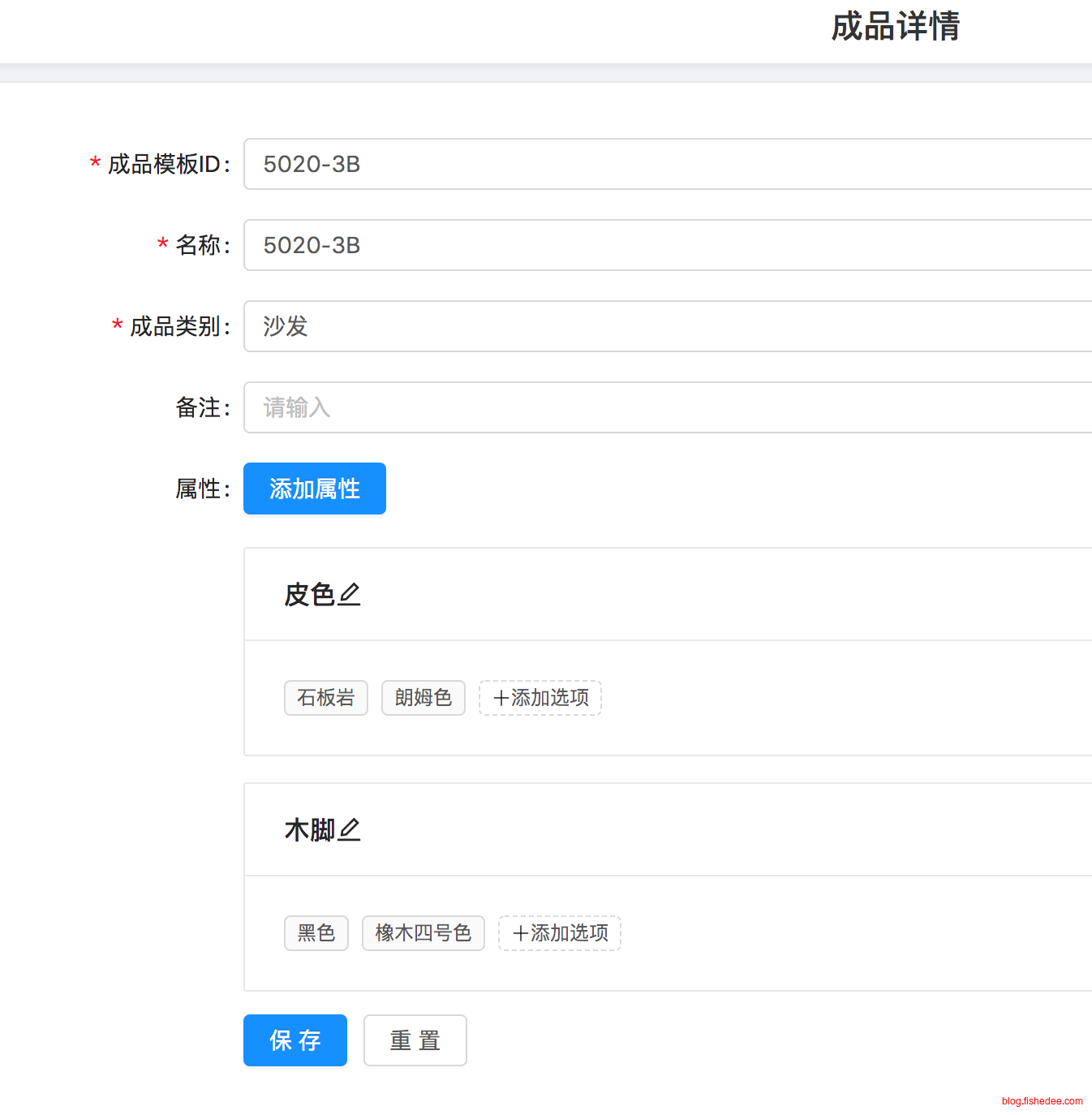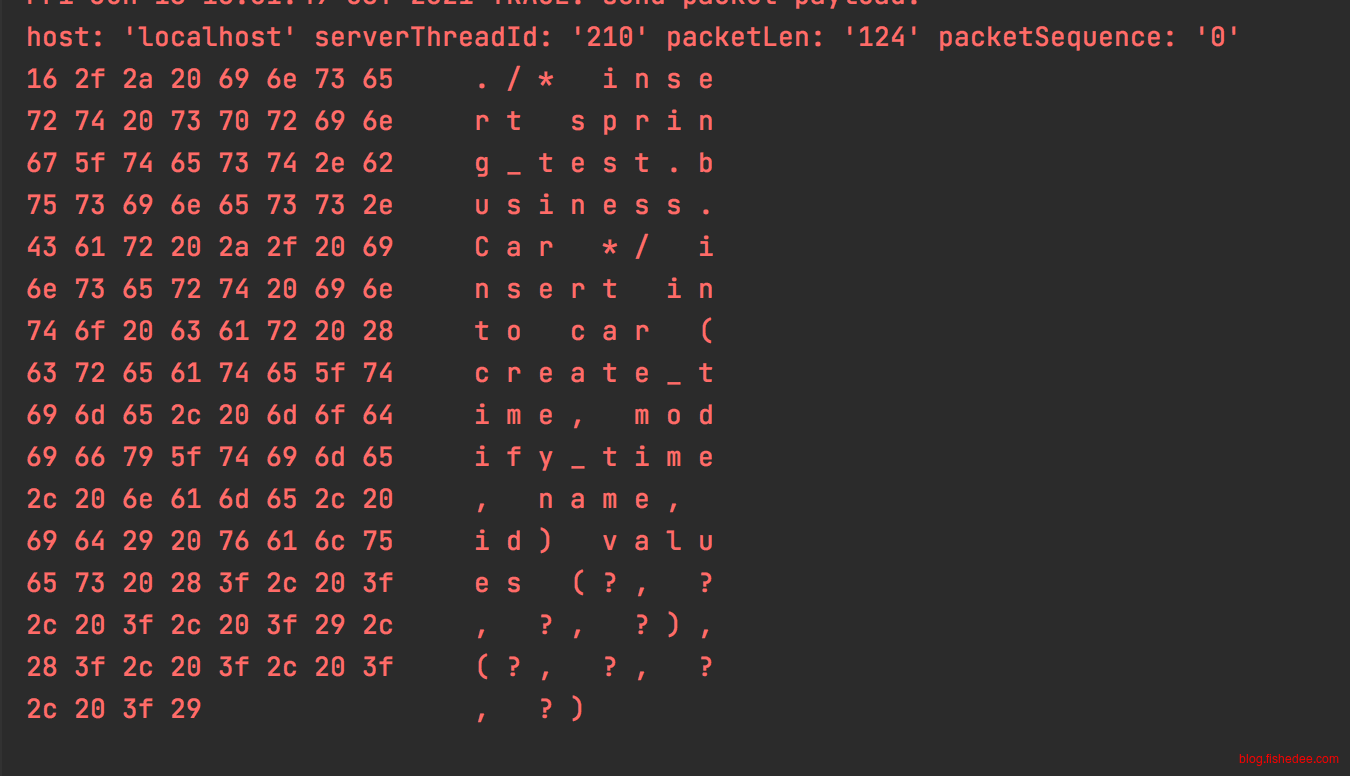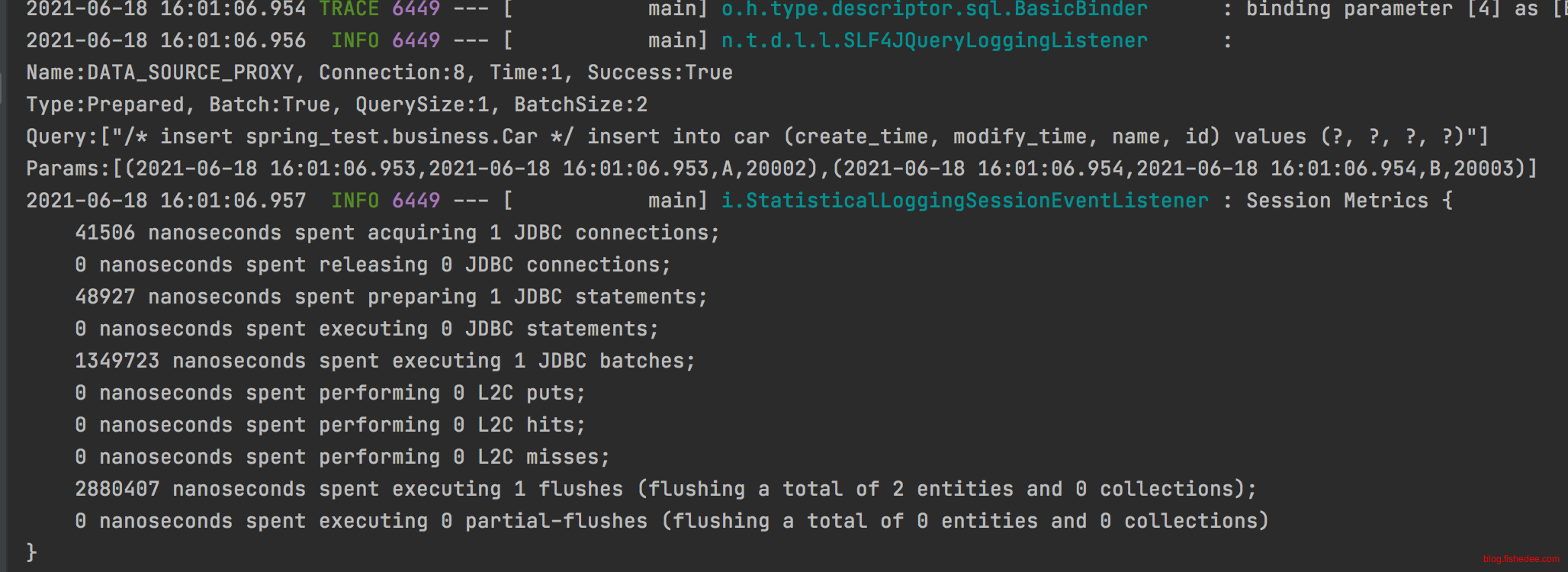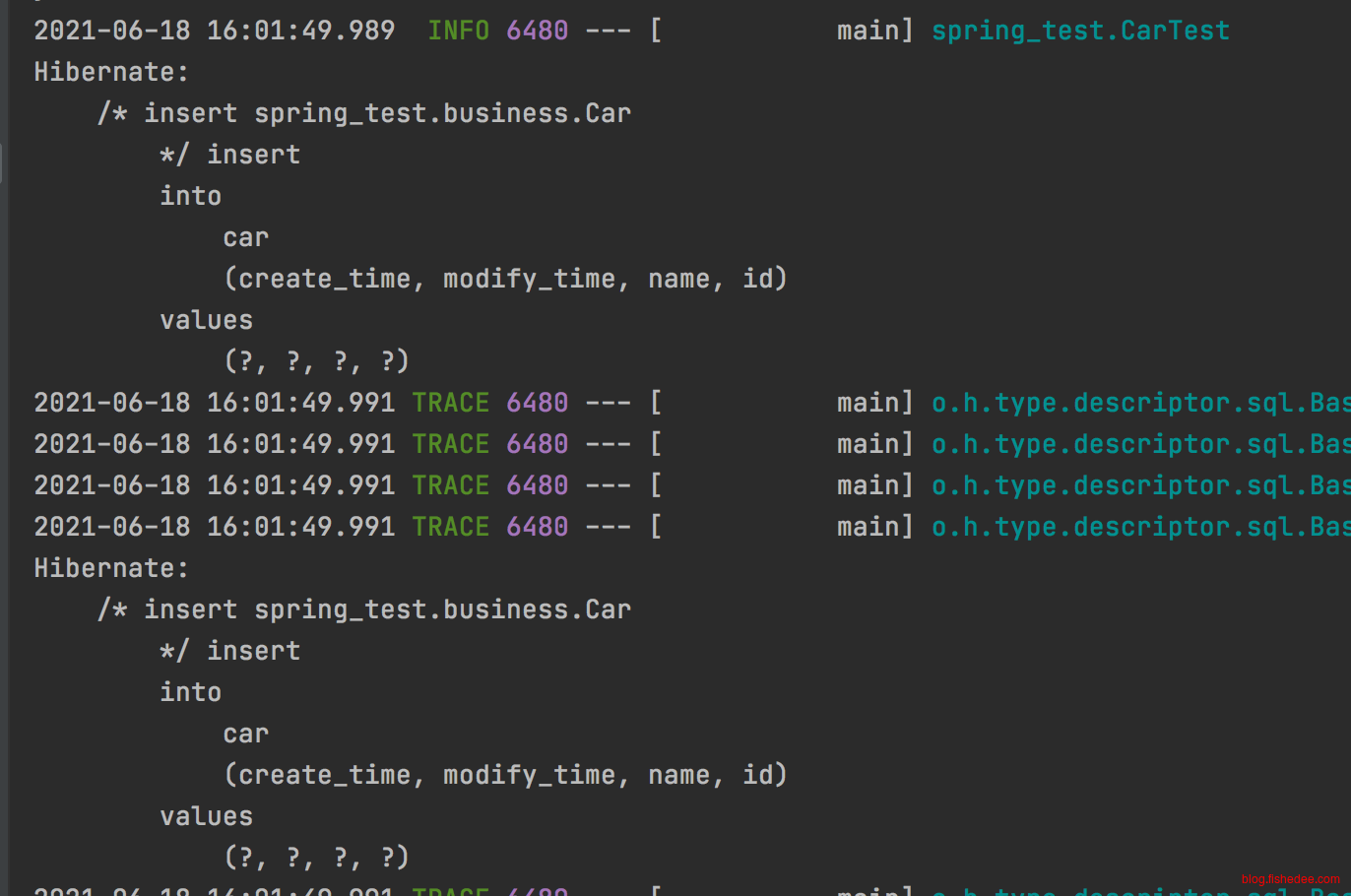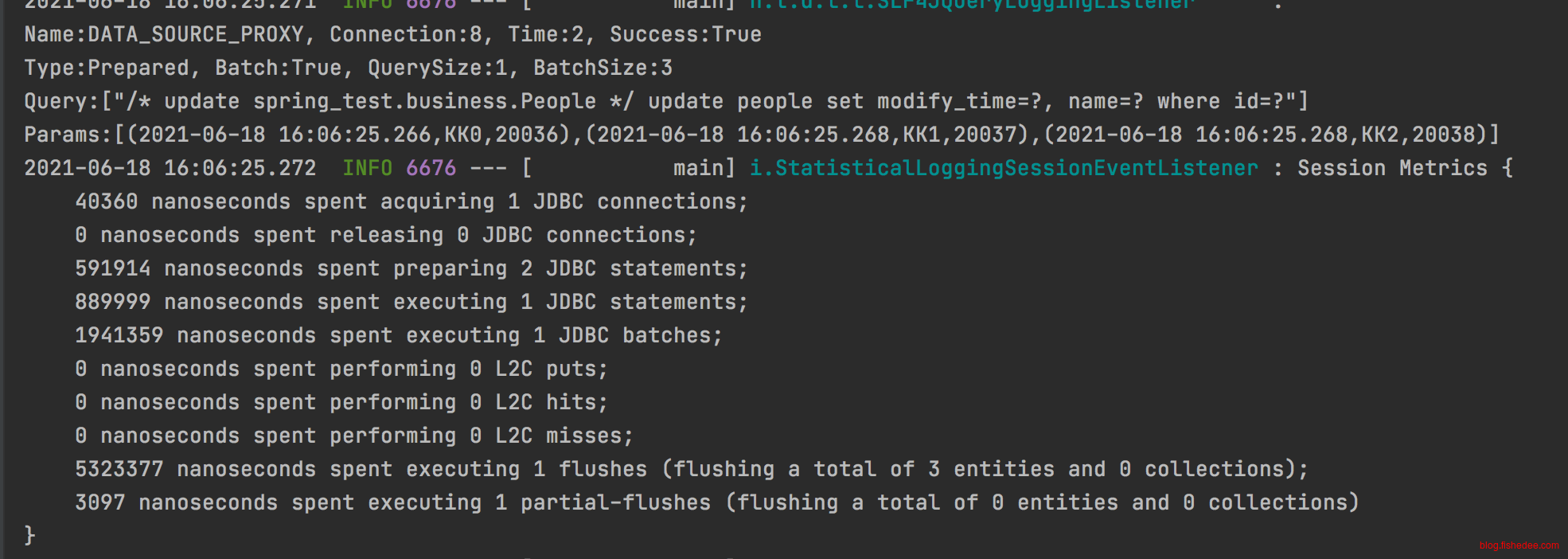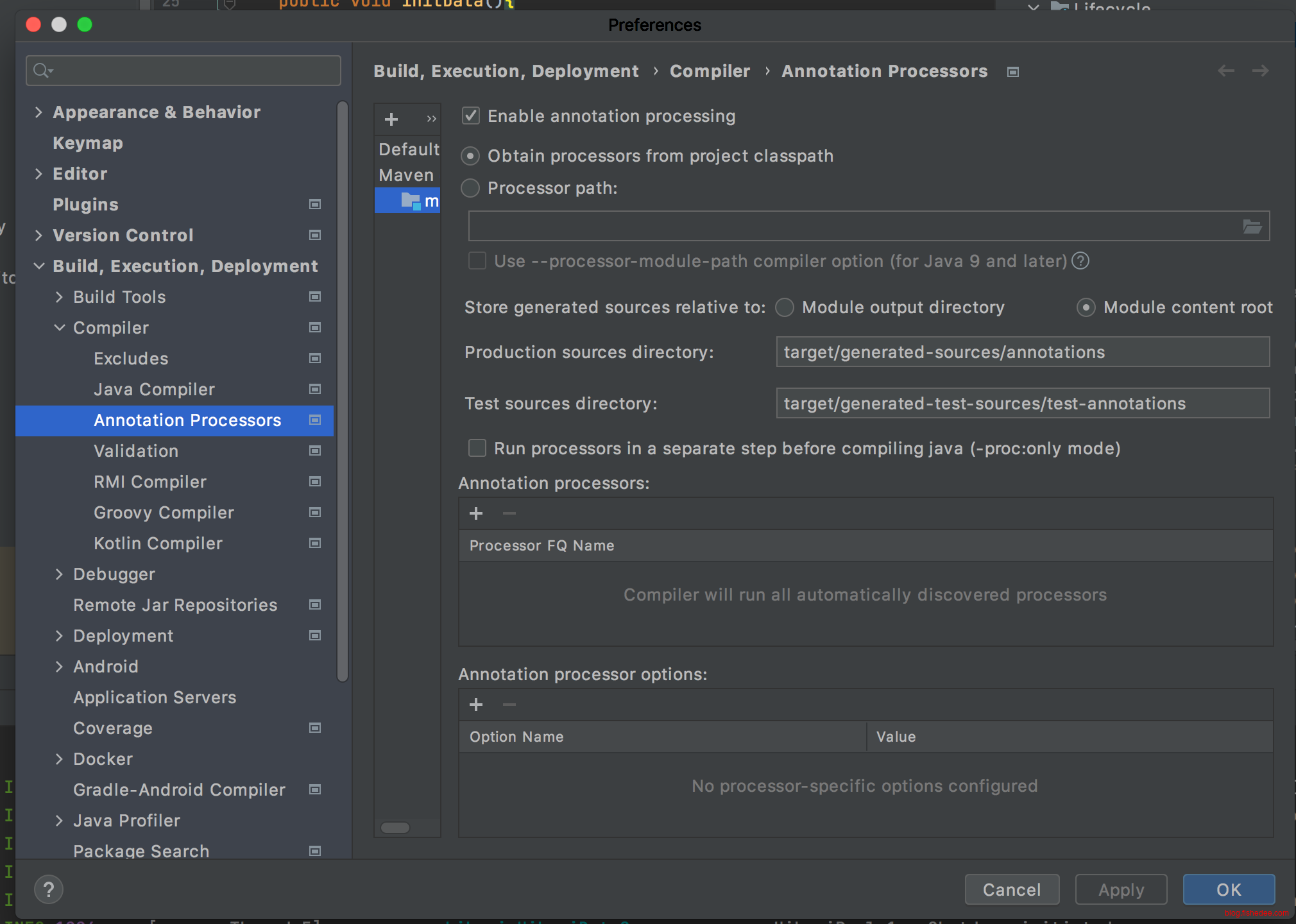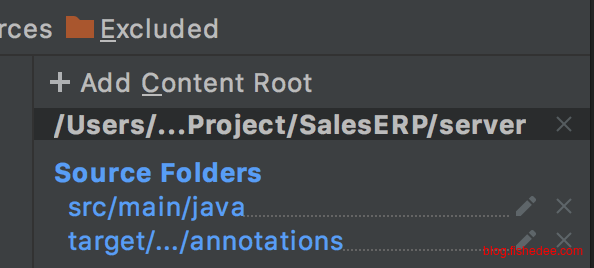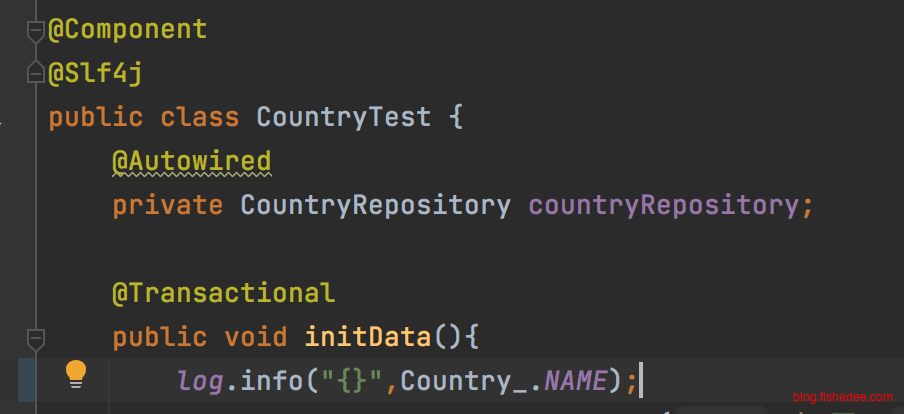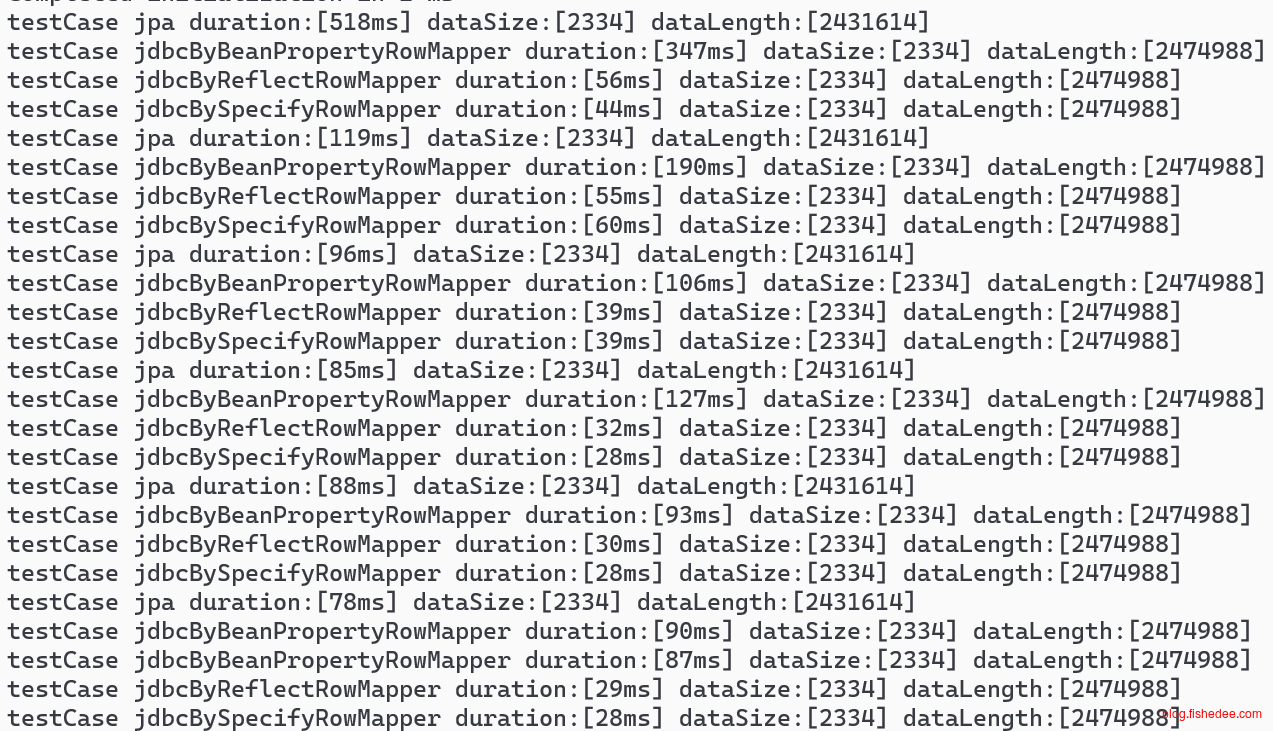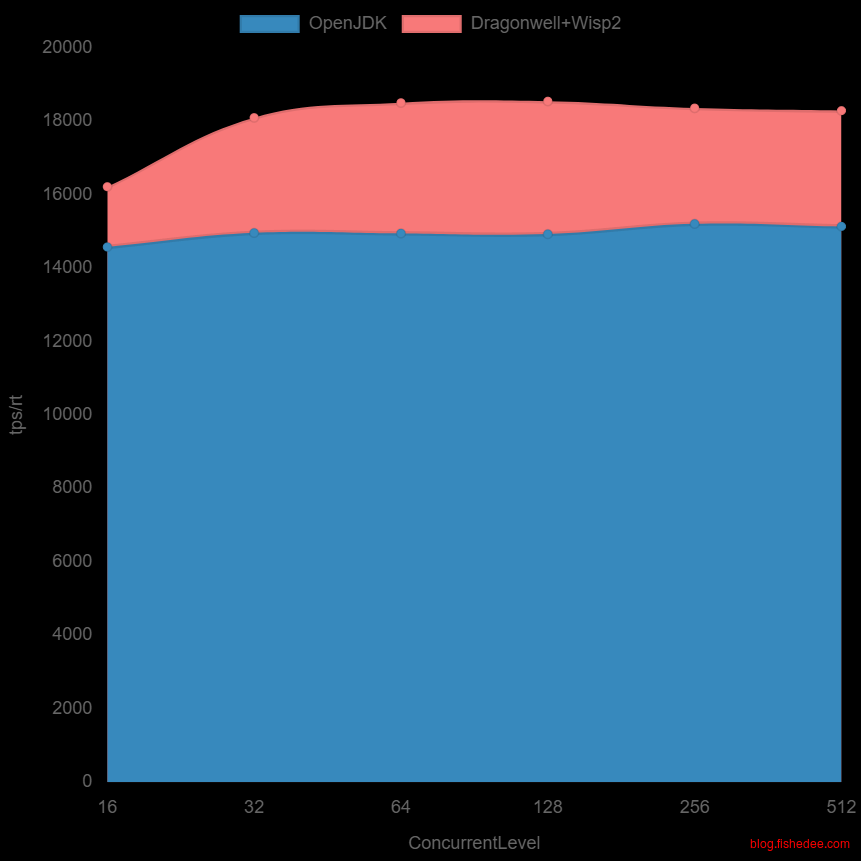1 概述
Hibernate是实现,JPA是接口。最早在大学的时候就知道Hibernate是个大坑,复杂,配置多,上手曲线异常复杂,直至现在国内都很少使用Hibernate的厂商。但是在DDD的实现中,均推荐使用Hibernate作为透明持久化层,我才狠心决心好好这本大部头。不过这本书比较旧了,没有讲如何与现代的Spring框架如何结合,要配搭着《Spring Data Jpa从入门到精通》这本书一起看。
总体来说,Hibernate其实是个好东西,精巧,省心。只是,我们都一直都误解他的用法了。
Hibernate相比MyBatis的主要优势在于:
- 透明更新,有自动脏检查进行update的能力,已经不再需要像MyBatis一样写update语句了。
- 关联关系批量拉取,我已经记不清有多少次写不好的程序都是在一个for循环里面逐个拉db数据,效率太差了。Hibernate能很优雅地解决这个问题,注意,N+1不是个问题。
- 一级缓存,MyBatis的一级缓存固定在单个方法上面的,不能跨方法对特定实体的一级缓存。Hibernate很好地解决这个问题,实现了优雅的批量写问题。
2 HelloWorld
2.1 原生
代码在这里
<?xml version="1.0" encoding="UTF-8"?>
<persistence version="2.1"
xmlns="http://xmlns.jcp.org/xml/ns/persistence"
xmlns:xsi="http://www.w3.org/2001/XMLSchema-instance"
xsi:schemaLocation="http://xmlns.jcp.org/xml/ns/persistence http://xmlns.jcp.org/xml/ns/persistence/persistence_2_1.xsd">
<persistence-unit name="HelloWorldPU" transaction-type="RESOURCE_LOCAL">
<class>spring_test.Country</class>
<exclude-unlisted-classes>true</exclude-unlisted-classes>
<properties>
<property name="hibernate.hbm2ddl.auto" value="create-drop"/>
<property name="hibernate.format_sql" value="true"/>
<property name="hibernate.use_sql_comments" value="true"/>
<!--show_sql可以打开sql看-->
<property name="hibernate.show_sql" value="true"/>
<property name="javax.persistence.jdbc.driver" value="com.mysql.cj.jdbc.Driver"/>
<property name="javax.persistence.jdbc.url" value="jdbc:mysql://localhost:3306/test2"/>
<property name="javax.persistence.jdbc.user" value="root"/>
<property name="javax.persistence.jdbc.password" value="1"/>
</properties>
</persistence-unit>
</persistence>首先在resources/META-INF下面,固定建立一个persistence.xml的文件
package spring_test;
import javax.persistence.*;
/**
* Created by fish on 2021/4/12.
*/
@Entity
@Table(name="t_country")
public class Country {
@Id
@GeneratedValue(strategy = GenerationType.IDENTITY)
private Long id;
private String countryName;
private String countryCode;
protected Country(){
}
public Long getId(){
return this.id;
}
public Country(String countryName,String countryCode){
this.countryCode = countryCode;
this.countryName = countryName;
}
public void mod(String countryName,String countryCode){
this.countryCode = countryCode;
this.countryName = countryName;
}
@Override
public String toString(){
return String.format("Country{id:%d,name:%s,code:%s}",id,countryName,countryCode);
}
}然后我们建立一个实体对象
package spring_test;
import javax.persistence.EntityManager;
import javax.persistence.EntityManagerFactory;
import javax.persistence.Persistence;
import java.util.List;
//import org.apache.log4j.Logger;
//import org.apache.log4j.Level;
public class App
{
public static void main( String[] args )
{
new App().go();
}
private EntityManagerFactory emf;
private void go(){
emf = Persistence.createEntityManagerFactory("HelloWorldPU");
this.go1();
this.go2();
}
private void go2(){
System.out.println("------------ go2 ------------");
showAll();
add2(new Country("我国1","WO"),new Country("我国2","WO2"));
showAll();
mod2();
mod3();
}
private void mod3(){
EntityManager em = emf.createEntityManager();
//没有开事务,但是依然会开一级缓存和脏检查
Country country1 = em.find(Country.class,4L);
System.out.println("before mod country : "+country1);
country1.mod("我国3","WO3");
System.out.println("after memory mod country : "+country1);
//即使没有开事务,读的依然是一级事务,
Country country2 = em.find(Country.class,4L);
System.out.println("after memory mod country2 : "+country2);
showOne(4L);
}
private void mod2(){
EntityManager em = emf.createEntityManager();
em.getTransaction().begin();
Country country4 = em.find(Country.class,4L);
country4.mod("我国3","WO3");
//这里走了一级缓存,因为在同一个事务里面
Country country5 = em.find(Country.class,4L);
System.out.println("reused EntityManager1 Country 4 : "+country5);
//事务回滚,或者提交后,自动清空一级缓存
em.getTransaction().rollback();
//数据库的旧数据,因为是rollback
showOne(4L);
//一级缓存被清空,所以,依然为旧数据
Country country6 = em.find(Country.class,4L);
System.out.println("reused EntityManager2 Country 4 : "+country6);
}
private void add2(Country country1,Country country2){
EntityManager em = emf.createEntityManager();
//没有transaction的时候,无法用
em.getTransaction().begin();
//执行修改操作的时候,必须打开transaction
em.persist(country1);
em.getTransaction().commit();
//一旦EntityManager关闭以后,就不能再继续使用EntityManager
//em.close();
//未关闭的情况下你可以继续使用EntityManager
em.getTransaction().begin();
em.persist(country2);
em.getTransaction().commit();
em.close();
}
private void go1(){
System.out.println("------------ go1 ------------ ");
showAll();
add("中国","CN");
add("美国","US");
add("英国","UK");
showAll();
showOne(1L);
showOne(2L);
showOne(3L);
del(2L);
mod(3L,"澳洲","AS");
showAll();
}
private void showAll(){
EntityManager em = emf.createEntityManager();
List<Country> countryList = em.createQuery("select c from Country c ",Country.class).getResultList();
System.out.println("allCountry "+countryList.toString());
//记得手动关闭EntityManager
em.close();
}
private void showOne(Long id){
EntityManager em = emf.createEntityManager();
Country country = em.find(Country.class,id);
System.out.println("country "+id+" : "+country);
em.close();
}
private void add(String countryName,String countryCode){
EntityManager em = emf.createEntityManager();
//没有transaction的时候,无法添加
em.getTransaction().begin();
//执行修改操作的时候,必须打开transaction
Country country = new Country(countryName,countryCode);
em.persist(country);
em.getTransaction().commit();
em.close();
}
private void del(Long id){
EntityManager em = emf.createEntityManager();
//没有transaction的时候,无法删除
em.getTransaction().begin();
//删除操作
Country country = em.find(Country.class,id);
em.remove(country);
em.getTransaction().commit();
em.close();
}
private void mod(Long id,String countryName,String countryCode){
EntityManager em = emf.createEntityManager();
//没有transaction的时候,无法修改
em.getTransaction().begin();
//修改操作,直接读出来改就行,EntityManager存放有内存快照,commit的时候会进行脏检查后update
Country country = em.find(Country.class,id);
country.mod(countryName,countryCode);
em.getTransaction().commit();
em.close();
}
}然后是一系列的CURD的操作,注意,JPA必须要在开启的事务的情况才能使用更新操作。它会将事务提交的时候,与内存的数据进行脏检查,然后执行对应的insert,delete和update操作。要点如下:
- 删除,添加,更新,依赖于事务开启
- 事务与EntityManager是独立的,事务提交以后,脏检查依然在EntityManager里面会自动清空
- EntityManager关闭以后就无法重新打开。所以每次事务都要使用一个新的EntityManager
- 在事务未开启时,EntityManager能开启一级缓存和脏检查,但是无法提交。
2.2 Spring
代码在这里
/**
* Created by fish on 2021/3/15.
*/
spring.datasource.driver-class-name = com.mysql.cj.jdbc.Driver
spring.datasource.url = jdbc:mysql://localhost:3306/Test
spring.datasource.username = root
spring.datasource.password = 1
logging.level.org.hibernate=INFO
spring.jpa.properties.hibernate.format_sql=true
spring.jpa.properties.hibernate.type=trace
spring.jpa.properties.hibernate.use_sql_comments=true
spring.jpa.properties.hibernate.show_sql=true
spring.jpa.properties.hibernate.hbm2ddl.auto=create-drop配置application.properties文件
package spring_test;
import javax.persistence.*;
/**
* Created by fish on 2021/4/12.
*/
@Entity
@Table(name="t_country")
public class Country {
@Id
@GeneratedValue(strategy = GenerationType.AUTO)
private Long id;
private String countryName;
private String countryCode;
protected Country(){
}
public Long getId(){
return this.id;
}
public Country(String countryName,String countryCode){
this.countryCode = countryCode;
this.countryName = countryName;
}
public void mod(String countryName,String countryCode){
this.countryCode = countryCode;
this.countryName = countryName;
}
@Override
public String toString(){
return String.format("Country{id:%d,name:%s,code:%s}",id,countryName,countryCode);
}
}配置相同的实体
package spring_test;
import org.springframework.stereotype.Component;
import javax.persistence.EntityManager;
import javax.persistence.PersistenceContext;
import java.util.List;
/**
* Created by fish on 2021/4/12.
*/
@Component
public class CountryRepository{
//在无事务的情况下,每次find,query,persist等操作对应的entityManager都是全新的
//在有事务的情况下,每次find,query,persist等操作对应的是同一个entityManager
@PersistenceContext
private EntityManager entityManager;
public List<Country> getAll(){
return entityManager.createQuery("select c from Country c",Country.class).getResultList();
}
public Country find(Long id){
return entityManager.find(Country.class,id);
}
public void add(Country country){
entityManager.persist(country);
}
public void del(Country country){
entityManager.remove(country);
}
}Spring对于EntityManager的第一步是,将EntityManager更改为不是与固定的事务绑定的,它的含义是:
- 在无事务的情况下,每次find,query,persist等操作对应的entityManager都是全新的
- 在有事务的情况下,每次find,query,persist等操作对应的是同一个entityManager
这样做,避免了每次都要重新创建EntityManager,而且事务结束时要注意关掉EntityManager的问题。在Spring中不再需要调用EntityManager的close了。这其实就是和MyBatis的SqlSessionTemplate同一个套路,可以看这里。注意,必须添加上PersistenceContext注解。
package spring_test;
import org.slf4j.Logger;
import org.slf4j.LoggerFactory;
import org.springframework.aop.framework.AopContext;
import org.springframework.beans.factory.annotation.Autowired;
import org.springframework.boot.ApplicationArguments;
import org.springframework.boot.ApplicationRunner;
import org.springframework.boot.SpringApplication;
import org.springframework.boot.autoconfigure.SpringBootApplication;
import org.springframework.context.annotation.Bean;
import org.springframework.context.annotation.EnableAspectJAutoProxy;
import org.springframework.orm.jpa.JpaTransactionManager;
import org.springframework.orm.jpa.LocalContainerEntityManagerFactoryBean;
import org.springframework.transaction.annotation.EnableTransactionManagement;
import org.springframework.transaction.annotation.Transactional;
import java.util.List;
import java.util.Optional;
/**
* Hello world!
*
*/
@SpringBootApplication
@EnableTransactionManagement(proxyTargetClass = true)
@EnableAspectJAutoProxy(exposeProxy = true)
public class App implements ApplicationRunner
{
private Logger logger = LoggerFactory.getLogger(getClass());
public static void main( String[] args )
{
SpringApplication.run(App.class,args);
}
@Autowired
private CountryRepository countryRepository;
@Transactional
public void add(Country country){
this.countryRepository.add(country);
}
@Transactional
public void mod(Long id,String countryName,String countryCode){
Country country = this.countryRepository.find(id);
country.mod(countryName,countryCode);
}
@Transactional
public void del(Long id){
Country country = this.countryRepository.find(id);
this.countryRepository.del(country);
}
public void showOne(Long id){
Country country = this.countryRepository.find(id);
logger.info("country {} : {}",id,country);
}
public void showAll(){
List<Country> countryList = countryRepository.getAll();
logger.info("countryList:{}",countryList);
}
public void go1(){
//调用自身类的其他方法,要用AopContext的currentProxy来做,否则AOP增强没有打开
App app = (App) (AopContext.currentProxy());
logger.info("------- go1 -----");
app.showAll();
app.add(new Country("中国","CN"));
app.add(new Country("美国","US"));
app.add(new Country("英国","UK"));
app.showAll();
app.showOne(1L);
app.showOne(2L);
app.showOne(3L);
app.del(2L);
app.mod(3L,"澳洲","AS");
app.showAll();
}
public void mod3(){
//没有开事务,但是依然会开一级缓存和脏检查
Country country1 = this.countryRepository.find(3L);
System.out.println("before mod country : "+country1);
country1.mod("我国3","WO3");
System.out.println("after memory mod country : "+country1);
//即使没有开事务,读的依然是一级事务
//但是PersistenceContext注入的EntityManager的生命周期与事务是是一一对应的,第二次执行find的时候已经是新的entityManager
Country country2 = this.countryRepository.find(3L);
System.out.println("after memory mod country2 : "+country2);
showOne(4L);
}
@Transactional
public void mod2Inner(){
Country country4 = this.countryRepository.find(4L);
country4.mod("我国3","WO3");
logger.info("reused EntityManager1 Country 4 : {}",country4);
//这里走了一级缓存,因为在同一个事务里面
Country country5 = this.countryRepository.find(4L);
logger.info("reused EntityManager2 Country 5 : {}",country5);
throw new RuntimeException("mm");
}
public void mod2(){
//调用自身类的其他方法,要用AopContext的currentProxy来做,否则AOP增强没有打开
App app = (App) (AopContext.currentProxy());
try{
app.mod2Inner();
}catch(Exception e){
//e.printStackTrace();
}
//数据库的旧数据,因为是rollback
showOne(4L);
}
@Transactional
public void add2(Country country1,Country country2){
this.countryRepository.add(country1);
this.countryRepository.add(country2);
}
public void go2() {
//调用自身类的其他方法,要用AopContext的currentProxy来做,否则AOP增强没有打开
App app = (App) (AopContext.currentProxy());
logger.info("------- go2 -----");
app.showAll();
app.add2(new Country("我国1","WO"),new Country("我国2","WO2"));
app.showAll();
app.mod2();
app.mod3();
}
public void run(ApplicationArguments arguments) throws Exception {
go1();
go2();
}
/*
@Bean
public JpaTransactionManager transactionManager(LocalContainerEntityManagerFactoryBean localContainerEntityManagerFactoryBean){
JpaTransactionManager transactionManager = new JpaTransactionManager();
transactionManager.setEntityManagerFactory(localContainerEntityManagerFactoryBean.getObject());
}
*/
}然后是例子代码,我们可以看到:
- 开事务可以简单地使用@Transactional注解,Spring会为我们创建一个新的EntityManager,在事务结束的时候,这个EntityManager会进行自动的脏检查更新操作,我们不再需要手动update了。
- 在开事务的时候,每次的EntityManager都是同一个,所以对find执行同样参数的操作,第一次要查数据库,第二次就不用查数据库了,走的是一级缓存。详情看mod2Inner方法。
- 在没有开事务的时候,每次的EntityManager都是全新的,每次一级缓存都是空的。所以,所以对find执行同样参数的操作,每一次都要查数据库。详情看mod3方法。
2.3 Spring Boot
代码在这里
/**
* Created by fish on 2021/3/15.
*/
spring.datasource.driver-class-name = com.mysql.jdbc.Driver
spring.datasource.url = jdbc:mysql://localhost:3306/Test
spring.datasource.username = root
spring.datasource.password = 1
logging.level.mybatis_test.mapper=DEBUGSpring Boot的配置文件
package spring_test;
import javax.persistence.*;
/**
* Created by fish on 2021/4/12.
*/
@Entity
@Table(name="t_country")
public class Country {
@Id
@GeneratedValue(strategy = GenerationType.IDENTITY)
private Long id;
private String countryName;
private String countryCode;
protected Country(){
}
public Long getId(){
return this.id;
}
public Country(String countryName,String countryCode){
this.countryCode = countryCode;
this.countryName = countryName;
}
public void mod(String countryName,String countryCode){
this.countryCode = countryCode;
this.countryName = countryName;
}
@Override
public String toString(){
return String.format("Country{id:%d,name:%s,code:%s}",id,countryName,countryCode);
}
}写一个实体
package spring_test;
import org.springframework.data.repository.CrudRepository;
/**
* Created by fish on 2021/4/12.
*/
public interface CountryRepository extends CrudRepository<Country,Long>{
}SpringBoot更进一步,使用了CrudRepository就能生成仓库,一行代码都不用写
package spring_test;
import org.slf4j.Logger;
import org.slf4j.LoggerFactory;
import org.springframework.aop.framework.AopContext;
import org.springframework.beans.factory.annotation.Autowired;
import org.springframework.boot.ApplicationArguments;
import org.springframework.boot.ApplicationRunner;
import org.springframework.boot.SpringApplication;
import org.springframework.boot.autoconfigure.SpringBootApplication;
import org.springframework.context.annotation.EnableAspectJAutoProxy;
import org.springframework.transaction.annotation.EnableTransactionManagement;
import org.springframework.transaction.annotation.Transactional;
import java.util.List;
import java.util.Optional;
/**
* Hello world!
*
*/
@SpringBootApplication
@EnableTransactionManagement(proxyTargetClass = true)
@EnableAspectJAutoProxy(exposeProxy = true)
public class App implements ApplicationRunner
{
private Logger logger = LoggerFactory.getLogger(getClass());
public static void main( String[] args )
{
SpringApplication.run(App.class,args);
}
@Autowired
private CountryRepository countryRepository;
@Transactional
public Long add() {
Country country = new Country("MyCountry","UK");
logger.info("countryRepository:{}",countryRepository);
countryRepository.save(country);
return country.getId();
}
@Transactional
public void del(Long id){
countryRepository.deleteById(id);
}
@Transactional
public void mod(Long id,String name,String code){
//不需要显式的save
Optional<Country> country = countryRepository.findById(id);
country.get().mod(name,code);
}
@Transactional
public void showAll(){
Iterable<Country> countryList = countryRepository.findAll();
logger.info("countryList:{}",countryList);
}
@Transactional
public void show(Long id){
Optional<Country> country = countryRepository.findById(id);
logger.info("country findById:{},{}",id,country);
}
public void run(ApplicationArguments arguments) throws Exception{
//调用自身类的其他方法,要用AopContext的currentProxy来做,否则AOP增强没有打开
App app = (App)(AopContext.currentProxy());
app.showAll();
Long newId = app.add();
app.show(newId);
app.mod(newId,"MyCountry2","UK2");
app.show(newId);
app.del(newId);
app.showAll();
}
}用法跟原来的一样。不过我不怎么喜欢org.springframework.data.repository.CrudRepository的实现,因为:
- 它默认把每个方法都带上了Transactional注解,让程序员把事务这件事变得透明化了。这是不对的,事务注解应该要让程序员显式指定,让他自己清楚为什么要这样做才对。
- CrudRepository的save方法也不好,它总是先find,然后决定是insert还是update操作,这是太傻的设计。你不能因为方便就把JPA的精髓盖住了,JPA里面只有一个persist方法,没有update方法。因为它认为程序员自己就能清楚这个实体是否要insert的。当一个已经持久化的实体,再次执行persist方法时,JPA会报错。但是Spring的CrudRepository方法就会执行update操作,这是把可能的错误盖住了。
3 基本类型
代码在这里
3.1 id与列
package spring_test.business;
import lombok.Getter;
import lombok.ToString;
import javax.persistence.*;
/**
* Created by fish on 2021/4/16.
*/
@Entity
@ToString
@Getter
//重写表名
@Table(name="t_people")
public class People {
//直接在hibernate_sequence获取下一个自增值,所有表共用一个自增值
//这样比IDENTITY的好处是,persist的时候不需要insert,而且可以批量在内存缓存多个主键,提高插入效率
@Id
@GeneratedValue(strategy = GenerationType.AUTO)
private Long id;
//重写列名
@Column(name="people_name")
private String name;
//数据库有CreateTime和ModifyTime字段,但是修改操作的时候没有取出来,所以不用
//可以只在query的时候才用这个字段
protected People(){
}
public People(String name){
this.name = name;
}
}@Id注解表达这个列的主键,注意,尽可能使用名称id,以及只有单列。对于列名为驼峰如wageId,它会自动转换为wage_id的名称保存下来。
@Column(name = "`key`")
private String key;有时候我们会遇到GammerException,Sql报错的时候,可能是列名刚好是SQL关键字导致的,这个时候要显式地告诉Hibernate,这个列名需要用特殊字符包围起来。
3.2 时间戳
package spring_test.business;
import lombok.Getter;
import lombok.ToString;
import org.hibernate.annotations.Generated;
import org.hibernate.annotations.GenerationTime;
import javax.persistence.*;
import java.util.Date;
/**
* Created by fish on 2021/4/12.
*/
@ToString
@Getter
@Entity
//默认的表名为country
//默认的实体名为Country
public class Country {
@Id
@GeneratedValue(strategy = GenerationType.IDENTITY)
private Long id;
//默认的列名为下划线形式,country_name
private String countryName;
private String countryCode;
//create_time字段是数据库自动生成的,所以insertable和updatable都为false,然后插入以后,要求hibernate从数据库取回这一行的列值
//如果不关注CreateTime,可以扔掉Generated注解
@Temporal(TemporalType.TIMESTAMP)
@Column(insertable = false,updatable = false)
@Generated(GenerationTime.INSERT)
private Date CreateTime;
//create_time字段是数据库自动生成的,所以insertable和updatable都为false,然后插入以后,要求hibernate从数据库取回这一行的列值
//如果不关注ModifyTime,可以扔掉Generated注解
@Temporal(TemporalType.TIMESTAMP)
@Column(insertable = false,updatable = false)
@Generated(GenerationTime.ALWAYS)
private Date ModifyTime;
protected Country(){
}
public Long getId(){
return this.id;
}
public Country(String countryName,String countryCode){
this.countryCode = countryCode;
this.countryName = countryName;
}
public void mod(String countryName,String countryCode){
this.countryCode = countryCode;
this.countryName = countryName;
}
}时间戳类型需要用@Temporal注解,因为JPA需要知道Date类型对应的是SQL里面的时间戳,还是日期类型。@Generated注解,这个注解是由数据库自动插入或更新的,需要在insert以后进行一次select操作取回这个数据。@Column注解的insertable=false与,updatable = false,表明JPA不会传递这个列的值
package spring_test.business;
import lombok.Getter;
import lombok.ToString;
import org.hibernate.annotations.CreationTimestamp;
import org.hibernate.annotations.UpdateTimestamp;
import javax.persistence.*;
import java.math.BigDecimal;
import java.util.Date;
/**
* Created by fish on 2021/4/16.
*/
@Entity
@ToString
@Getter
public class Car2 {
private static Long globalId = 20001L;
//改用自己的id生成算法
@Id
private Long id;
private String name;
//可以设置为由Hibernate来生成时间戳
@Temporal(TemporalType.TIMESTAMP)
@CreationTimestamp
@Column(updatable = false)
private Date createTime;
@Temporal(TemporalType.TIMESTAMP)
@UpdateTimestamp
private Date modifyTime;
private Long generateId(){
Long id = Car2.globalId++;
return id;
}
protected Car2(){
//这个不要设置id,这个protected是由JPA读取数据后自动填充用的
//即使设置了generateId,JPA也不会将id使用update语句写入到数据库,因为JPA默认id是不可改变的。但是,这样做会让id增长不是连续的。
//this.id = generateId();
}
public Car2(String name){
this.id = generateId();
this.name = name;
}
public void mod(String name){
this.name = name;
}
}另外一种办法是用@CreationTimestamp和@UpdateTimestamp注解,这样的时间戳是由JPA生成放进去的,避免了插入后的select操作。。而且,另外一个,使用自己生成的id,能高效地避免再一次select主键,或者读取hibernate_sequence的开销。
3.3 枚举值
package spring_test.business;
/**
* Created by fish on 2021/4/17.
*/
public enum CarBrand {
Toyota,
Honda,
BMW,
LEXUS,
}我们定义一个枚举值
package spring_test.business;
import lombok.Getter;
import lombok.ToString;
import org.hibernate.annotations.CreationTimestamp;
import org.hibernate.annotations.UpdateTimestamp;
import javax.persistence.*;
import java.math.BigDecimal;
import java.util.Date;
/**
* Created by fish on 2021/4/16.
*/
@Entity
@ToString
@Getter
public class Car {
@Id
@GeneratedValue(strategy = GenerationType.AUTO)
private Long id;
private String name;
//使用enum作为映射对象,将枚举的字符串写入数据库,注意,枚举的值是区分大小写的.
@Enumerated(EnumType.STRING)
private CarBrand brand;
private BigDecimal price;
//可以设置为由Hibernate来生成时间戳
@Temporal(TemporalType.TIMESTAMP)
@CreationTimestamp
@Column(updatable = false)
private Date createTime;
@Temporal(TemporalType.TIMESTAMP)
@UpdateTimestamp
private Date modifyTime;
protected Car(){
}
public Car(CarBrand carBrand,String name,BigDecimal price){
this.brand = carBrand;
this.name = name;
this.price = price;
}
public void mod(CarBrand carBrand,String name,BigDecimal price){
this.brand = carBrand;
this.name = name;
this.price = price;
}
}我们发现:
- 另外一种使用时间戳的方式, @CreationTimestamp注解与@UpdateTimestamp注解,它与@Generated注解的区别是,时间戳是由JPA生成的,而不是依赖于数据库机制生成的
- 枚举值,可以用@Enumerated(EnumType.STRING)来表明使用枚举值的字符串来保存,而不是使用默认的枚举值的ordinal来保存。
- 大数,BigDecimal直接就能存取,不需要任何注解
4 嵌入与继承
嵌入与继承是JPA里面一个重要的机制。代码在这里
4.1 嵌入类
package spring_test.business;
import lombok.AllArgsConstructor;
import lombok.EqualsAndHashCode;
import lombok.Getter;
import lombok.ToString;
import javax.persistence.Embeddable;
/**
* Created by fish on 2021/4/18.
*/
//Embeddable默认会继承实体的访问方式,因为User是按字段赋值的,所以Address也是用字段赋值的
@Embeddable
@ToString
@EqualsAndHashCode
@AllArgsConstructor
@Getter
public class Address {
private String country;
private String city;
private String street;
private String zipcode;
protected Address(){
}
}我们先使用一个Address类型在嵌入,注意必须要用@Embeddable注解
package spring_test.business;
import lombok.AllArgsConstructor;
import lombok.Getter;
import lombok.ToString;
import javax.persistence.Entity;
import javax.persistence.GeneratedValue;
import javax.persistence.GenerationType;
import javax.persistence.Id;
/**
* Created by fish on 2021/4/18.
*/
@Entity
@ToString
@Getter
public class User {
@Id
@GeneratedValue(strategy = GenerationType.AUTO)
private Long id;
private String name;
private Address address;
protected User(){
}
public User(String name,Address address){
this.name = name;
this.address = address;
}
public void mod(String name,Address address){
this.name = name;
this.address = address;
}
}然后我们在User实体(带有@Entity注解)上,直接使用这个Address类型。那么,JPA存取数据库的时候,就会直接将Address类型的字段都平摊在user表上面了。就是说,user表用id,name,country,city,street,和zipcode这几个字段。
4.2 嵌入类的字段改名
package spring_test.business;
import lombok.Getter;
import lombok.ToString;
import javax.persistence.*;
/**
* Created by fish on 2021/4/18.
*/
@Entity
@ToString
@Getter
public class Student {
@Id
@GeneratedValue(strategy = GenerationType.AUTO)
private Long id;
private String school;
private String name;
//重写Address的某一个字段名,其他字段名保持不变
@AttributeOverrides({
@AttributeOverride(name="street",column=@Column(name="student_street"))
})
private Address address;
protected Student(){
}
public Student(String school,String name,Address address){
this.school = school;
this.name = name;
this.address = address;
}
public void mod(String school,String name,Address address){
this.school = school;
this.name = name;
this.address = address;
}
}我们可以在实体Student里面,修改嵌入类在数据库里面的字段名,用的是@AttributeOverrides属性。
4.3 继承类
package spring_test.business;
import lombok.Getter;
import lombok.ToString;
import javax.persistence.MappedSuperclass;
/**
* Created by fish on 2021/4/18.
*/
@MappedSuperclass
@ToString
@Getter
public class Order {
private String total;
private String remark;
private String owner;
protected Order(){
}
public Order(String total,String owner,String remark){
this.total = total;
this.owner = owner;
this.remark = remark;
}
public void setRemark(String remark){
this.remark = remark;
}
}使用@MappedSuperclass声明一个基类,注意用这种方法声明的类,不能作为JPA里面的多态类,纯粹就是用来减少代码的。不能在一个@ElementCollection注解里面存放Order类。
package spring_test.business;
import lombok.Getter;
import lombok.ToString;
import javax.persistence.Entity;
import javax.persistence.GeneratedValue;
import javax.persistence.GenerationType;
import javax.persistence.Id;
/**
* Created by fish on 2021/4/18.
*/
//注意ToString,要调用父类的方法,否则会输出不了
@Entity
@ToString(callSuper = true)
@Getter
public class SalesOrder extends Order{
@Id
@GeneratedValue(strategy = GenerationType.AUTO)
private Long id;
private String salesName;
protected SalesOrder(){
}
public SalesOrder(String salesName,String total,String owner,String remark){
super(total,owner,remark);
this.salesName = salesName;
}
public void modSalesName( String salesName){
this.salesName = salesName;
}
}然后我们声明一个SalesOrder类,继承于含有@MappedSuperclass注解的Order类。那么JPA就会将sales_order表的字段定义为id,sales_name,total,remark,owner。注意,你可以将id字段放入到基类Order中。
继承类与嵌入类不同的是,嵌入类是组合关系,没有继承方法的,继承类是派生关系,有继承方法的。
4.4 继承类的字段改名
package spring_test.business;
import lombok.Getter;
import lombok.ToString;
import javax.persistence.*;
/**
* Created by fish on 2021/4/18.
*/
@Entity
@ToString(callSuper = true)
@Getter
//修改了父级的列名,其他列保持不变
@AttributeOverrides({
@AttributeOverride(name="remark",column = @Column(name="purchase_remark"))
})
public class PurchaseOrder extends Order{
@Id
@GeneratedValue(strategy = GenerationType.AUTO)
private Long id;
private String company;
protected PurchaseOrder(){
}
public PurchaseOrder(String company,String total,String owner,String remark){
super(total,owner,remark);
this.company = company;
}
public void modCompany( String company){
this.company = company;
}
}同理,我们可以用@AttributeOverrides属性修改列属性。
4.5 组合主键
package spring_test.business;
import lombok.EqualsAndHashCode;
import lombok.Getter;
import lombok.ToString;
import javax.persistence.Embeddable;
import javax.persistence.EmbeddedId;
import javax.persistence.Entity;
import javax.persistence.Id;
import java.io.Serializable;
/**
* Created by fish on 2021/4/18.
*/
@Entity
@ToString
@Getter
public class UserFollow {
//使用复合主键的时候,必须要重写equals和hashCode代码,否则会有问题
@Embeddable
@ToString
@EqualsAndHashCode
@Getter
public static class Id implements Serializable{
private Long userId;
private Long followUserId;
protected Id(){
}
public Id(Long userId,Long followUserId){
this.userId = userId;
this.followUserId = followUserId;
}
}
@EmbeddedId
private Id id;
protected UserFollow(){
}
public UserFollow(Long userId,Long followUserId){
this.id = new Id(userId,followUserId);
}
}当我们需要多个字段来成为组合主键的时候,就需要使用@Embeddable注解,和@EmbeddedId注解。注意,必须要重写组合主键的equals和hashCode方法。
5 集合
集合是JPA里面最重要的关系,也是比一般手写SQL代码要大幅减少代码的一种抽象方式。集合可以认为是DDD中的一个聚合根(绝大部分的情况)。代码在这里
5.1 Set集合
package spring_test.business;
import lombok.Getter;
import lombok.ToString;
import org.hibernate.annotations.BatchSize;
import org.hibernate.annotations.Fetch;
import org.hibernate.annotations.FetchMode;
import org.hibernate.annotations.Table;
import org.springframework.data.repository.cdi.Eager;
import javax.persistence.*;
import java.util.Collections;
import java.util.HashSet;
import java.util.Set;
/**
* Created by fish on 2021/4/19.
*/
@Entity
@ToString
@Getter
public class SalesOrder {
@Id
@GeneratedValue
private Long id;
//eager加batchSize能有效避免N+1的问题
@ElementCollection(fetch= FetchType.EAGER)
@BatchSize(size=100)
@CollectionTable(
name="sales_order_user",
joinColumns = @JoinColumn(name="sales_order_id")
)
@Column(name="user_id")
@Fetch(FetchMode.SELECT)
private Set<Long> users = new HashSet<Long>();
public SalesOrder(){
}
//注意,lombok自动生成getter方法返回的是可修改Set
public Set<Long> getUsers(){
//返回禁止被修改的set列表,外部只能进行读取操作
return Collections.unmodifiableSet(users);
}
public void addUser(Long userId){
this.users.add(userId);
}
}对于一个普通的Set<Long>类型users,我们可以用@ElementCollection来指定这个Set是集合类型的,另外,因为默认集合都是LAZY加载,我们要强制指定为EAGER加载。最后我们可以用@CollectionTable和@Column来强行指定默认的命名。默认没有这两个字段的时候,会产生sales_order_users表,以及sales_order_users表下的sales_order_id列与user列
当我们有了@ElementCollection类型以后,我们对Set类型的添加和修改操作,JPA会自动进行脏检查,进行对应的insert与delete的SQL操作,我们不需要额外干预。
5.2 List集合
package spring_test.business;
import lombok.AllArgsConstructor;
import lombok.Getter;
import lombok.ToString;
import org.hibernate.annotations.BatchSize;
import org.hibernate.annotations.Fetch;
import org.hibernate.annotations.FetchMode;
import javax.persistence.*;
import java.math.BigDecimal;
import java.util.ArrayList;
import java.util.Collections;
import java.util.List;
/**
* Created by fish on 2021/4/19.
*/
@Entity
@ToString
@Getter
public class PurchaseOrder {
//List嵌入对象的时候,要用Embeddable,且必须为static class
@Embeddable
@ToString
protected static class Item {
private Long itemId;
private BigDecimal price;
private BigDecimal amount;
private BigDecimal total;
protected Item(){
}
public Item(Long itemId,BigDecimal price,BigDecimal amount){
this.itemId = itemId;
this.price = price;
this.amount = amount;
this.total = this.price.multiply(this.amount);
}
public BigDecimal getTotal(){
return this.total;
}
}
@Id
@GeneratedValue
private Long id;
//会生成items_order列,作为排序的依据
//默认为Join拉取,要改为SELECT拉取,才能避免笛卡尔积
//不要用SUBSELECT,会产生嵌套子查询复制原sql的问题
@ElementCollection(fetch = FetchType.EAGER)
@BatchSize(size=1000)
@Fetch(FetchMode.SELECT)
@OrderColumn
private List<Item> items = new ArrayList<>();
private BigDecimal total = new BigDecimal("0");
public PurchaseOrder(){
}
public void addItem(Long itemId,BigDecimal price,BigDecimal amount){
Item newItem = new Item(itemId,price,amount);
this.items.add(newItem);
this.total = this.total.add(newItem.getTotal());
}
public void remove(int index){
//删除的时候会生成多个sql
//第一个sql为删除所在行
//第二个sql为给后面的行的orderColumn减去1
this.items.remove(index);
}
public List<Item> getItems(){
return Collections.unmodifiableList(this.items);
}
}我们也可以用List集合,@OrderColumn会产生一个items_order列,来标记每个记录的顺序,保证下次取出的时候也会保持原来的顺序,相当省事和重要。另外,注意Item必须要用@Embeddable注解,并且是static class的类型。
最后,由于有items_order列来标记记录的顺序,所以当你删除头部数据的时候,会产生多条SQL。首先会delete一行,然后会update后面的多个行。
5.3 Map集合
package spring_test.business;
import lombok.AllArgsConstructor;
import lombok.Getter;
import lombok.ToString;
import org.hibernate.annotations.BatchSize;
import org.hibernate.annotations.Fetch;
import org.hibernate.annotations.FetchMode;
import javax.persistence.*;
import java.math.BigDecimal;
import java.util.HashMap;
import java.util.Map;
/**
* Created by fish on 2021/4/19.
*/
@Entity
@ToString
@Getter
public class MaterialStockOrder {
@Embeddable
@ToString
@Getter
public static class Material{
private Long materialId;
private BigDecimal amount;
private Long unitId;
protected Material(){
}
public Material(Long materialId,BigDecimal amount,Long unitId){
this.materialId = materialId;
this.amount = amount;
this.unitId = unitId;
}
}
@Id
@GeneratedValue
private Long id;
//默认列名为items_key,可以用@MapKeyColumn注解修改
@ElementCollection(fetch = FetchType.EAGER)
@BatchSize(size=1000)
@Fetch(FetchMode.SELECT)
//@MapKeyColumn(name="key")
private Map<Long,Material> items = new HashMap<>();
private int itemSize;
public MaterialStockOrder(){
}
public void removeItem(Long id){
this.items.remove(id);
this.itemSize = this.items.size();
}
public void addItem(Material material){
this.items.put(material.getMaterialId(),material);
this.itemSize = this.items.size();
}
}Map集合,默认Key的列名为items_key,我们可以用@MapKeyColumn注解来覆盖这个设定
5.4 Collection集合
package spring_test.business;
import lombok.AllArgsConstructor;
import lombok.Getter;
import lombok.ToString;
import org.hibernate.annotations.CollectionId;
import org.hibernate.annotations.Fetch;
import org.hibernate.annotations.FetchMode;
import org.hibernate.annotations.Type;
import javax.persistence.*;
import java.math.BigDecimal;
import java.util.ArrayList;
import java.util.Collection;
/**
* Created by fish on 2021/4/20.
*/
@Entity
@ToString
@Getter
public class ItemStockOrder {
@Embeddable
@ToString
@Getter
@AllArgsConstructor
public static class Item{
private Long itemId;
private BigDecimal amount;
private String itemName;
protected Item(){
}
}
@Id
@GeneratedValue(strategy = GenerationType.AUTO)
private Long id;
//Collection的主键可以设置为自增的
//也可以自定义主键生成策略
//Collection的主键是隐形的,所以每次数据更新的时候,Hibernate总是清空整个collection,再重新插入数据
//注意插入的时候不是用insert values,而是用多个insert ... value (),然后用jdbc.batch_size来优化
@ElementCollection(fetch = FetchType.EAGER)
@Fetch(FetchMode.SELECT)
//@CollectionId(columns = @Column(name="item_stock_order_item_id"),
// type=@Type(type="long"),
// generator = "global_identity")
private Collection<Item> items = new ArrayList<>();
public ItemStockOrder(){
}
public void addItem(Item item){
this.items.add(item);
}
public void removeItem(Item item){this.items.remove(item);}
public void removeFirst(){
if( this.items.size() != 0){
this.items.remove(this.items.iterator().next());
}
}
public void clearItem(){this.items.clear();}
}Collection集合的特点是,它总是有一个CollectionId的自增列。另外,Collection的脏检查相当暴力,总是清除原来的所有数据,然后重新insert新数据。
5.5 原则
5.5.1 原理
原理:
- JPA的集合自动生成SQL依赖于各个集合的脏检查机制,当集合的地址发生变化时,它总是认为数据已经全部变化了,所以不要试图将新的集合赋值到原来的集合上。
- 不同集合的脏检查机制不同,要了解它的变化,也要理解生成的SQL是怎样的。
5.5.2 集合注解
在使用集合的时候,我们有以下原则:
- fetch必须指定为eager方式,不能指定为lazy方式。因为懒加载在脱离了@Transciation以后就无法加载了,而且站在DDD的角度,如果使用懒加载来加载一个聚合根的其他实体,那么这个聚合根是不合理的(聚合根太大,也缺乏内聚性),你应该切分为多个聚合根。
- 必须指定BatchSize,当然你也可以在JPA配置文件中全局指定。没有BatchSize的加载会产生N+1的问题,严重拉低性能
- 必须指定SELECT的加载方式,SUBSELECT会产生子查询的问题,复杂查询时会产生问题。JOIN加载会产生冗余的笛卡尔积(当一个实体有多个集合时,JOIN查询产生的加载会造成数据集过大而且大幅冗余浪费)的问题。
- Map的key,Set的内容,都必须使用基础类型,Int,Long或者String,尽可能避免自己新建的类型,否则坑很多。
5.5.3 全局配置
#每个请求一条数据库连接,并不建议用,当遇到第三方外部请求时,会拖垮数据库连接资源
#spring.jpa.open-in-view=true
#开启在非事务位置,打开lazy_load,不建议用,会产生N+1问题
#spring.jpa.properties.hibernate.enable_lazy_load_no_trans=true
#https://prasanthmathialagan.wordpress.com/2017/04/20/beware-of-hibernate-batch-fetching,关键问题
#default_batch_fetch_size描述的是OneToMany,和ManyToMany的时候,单次批量拉取的数量,越大越好,但是会占用多一点内存,这是解决N+1问题的关键
#https://blog.csdn.net/weixin_30484739/article/details/94986283
#batch_fetch_style为LEGACY的时候,固定的SQL参数数量,总是为分裂为多条SQL执行,39条数据用14+14+10+1的方法拉取
#batch_fetch_style为PADDED的时候,会用固定填充的方法拉取,39条数据用14+14+14(填充3个)的方法拉取
#batch_fetch_style为DYNAMIC的时候,会用动态填充参数的方法拉取,39条数据用1次39条的方法拉取
spring.jpa.properties.hibernate.batch_fetch_style = DYNAMIC
spring.jpa.properties.hibernate.default_batch_fetch_size=1000
#https://blog.csdn.net/seven_3306/article/details/9303879
#读取数据的时候,使用游标读取,每次fetch_size为50条数据.
#在mysql中,不设置fetch_size就会每次一次性拉数据,其实问题也不大.
#spring.jpa.properties.hibernate.jdbc.fetch_size = 50
#https://github.com/JavaWiz/sb-jpa-batch-insert
#写入数据的时候,可以将多条SQL语句合并一次性发送给服务器,这个参数就是batch_size,可以大幅提高写入效率,减少数据库与应用层的网络来回次数
spring.jpa.properties.hibernate.jdbc.batch_size = 30
#按照不同的表,将表排序后,将同一个表的数据批量提交,这个意义比较大,建议打开
#https://www.baeldung.com/jpa-hibernate-batch-insert-update#:~:text=Batch%20Insert%2FUpdate%20with%20Hibernate%2FJPA%201%20Overview.%20In%20this,7%20%40Id%20Generation%20Strategy.%20...%208%20Summary.%20
spring.jpa.properties.hibernate.order_inserts = true
#按照批量更新行的主键进行排序,这样能有效避免高并发下的死锁,超高并发才有意义
#spring.jpa.properties.hibernate.order_updates=trueJPA配置文件的全局配置项如上
6 关联
JPA的关联是噩梦之源,我们应该尽可能避免使用关联机制。代码在这里。JPA关联机制的问题在于:
- 需要仔细知道谁是关系的写入端,谁是关系的读取端。JPA根据写入端进行脏检查,读取端需要开发者仔细手动维护。开发者在写入端写入后,如果忘了在读取端同步维护就会产生隐晦的bug。
- Cascade与orphalRemove机制复杂
6.1 单向无persist关系
package spring_test.business;
import org.hibernate.annotations.Proxy;
import javax.persistence.Entity;
import javax.persistence.GeneratedValue;
import javax.persistence.GenerationType;
import javax.persistence.Id;
/**
* Created by fish on 2021/4/22.
*/
@Entity
@Proxy(lazy=false)
public class People {
@Id
@GeneratedValue(strategy = GenerationType.AUTO)
private Long id;
private String name;
protected People(){
}
public People(String name){
this.name = name;
}
}首先,我们声明一个People实体
package spring_test.business;
import lombok.ToString;
import javax.persistence.*;
import java.util.ArrayList;
import java.util.List;
/**
* Created by fish on 2021/4/22.
*/
@Entity
@ToString
public class Country {
@Id
@GeneratedValue(strategy = GenerationType.AUTO)
private Long id;
private String name;
//OneToMany额外的@JoinColumn字段指定了peopleList是在关系的写入端
@OneToMany(fetch = FetchType.LAZY)
@JoinColumn(name = "country_id")
private List<People> peopleList = new ArrayList<>();
protected Country(){
}
public Country(String name){
this.name = name;
}
public void addPeople(People people){
this.peopleList.add(people);
}
}然后我们使用@OneToMany来包含这个People类型,但是注意,People实体里面并没有对Country引用的字段。由于@OneToMany中包含了@JoinColumn的字段,所以Country是对peopleList这段关系的写入端,people没有对Country的读取端。
@Transactional
public void add1(){
//org.hibernate.TransientObjectException: object references an unsaved transient instance
//这个测试会报出以上的异常,因为people加进了Country里面,但是people没有进行persist操作
//Country的List检查到了添加People的操作,但是People自身没有进行persist
Country country = new Country("中国");
countryRepository.add(country);
People people1 = new People("fish");
People people2 = new People("cat");
country.addPeople(people1);
country.addPeople(people2);
}以上测试代码会报错,因为People是一个实体,而不是嵌入类,在提交的时候,必须要将people持久化了以后放入people_list里面才能进行有效的脏检查。
@Transactional
public void add2(){
//这样就正确了,不仅需要添加进country,会要对people自身进行persist操作
//但是,报错了这个错误Field 'country_id' doesn't have a default value,因为People缺少country_id的字段
Country country = new Country("中国");
countryRepository.add(country);
People people1 = new People("fish");
People people2 = new People("cat");
peopleRepository.add(people1);
peopleRepository.add(people2);
country.addPeople(people1);
country.addPeople(people2);
}我们对放入到people_list里面放入已经持久化的People,依然会报错。因为People是一个实体,已经被外部persist了。脏检查的时候发现它是新增的数据,同时已经被持久化了,所以country就会忽略它,没有设置它的country_id字段,导致插入数据库的时候,这个字段为空,报错了。
从中,我们可以看出,脏检查发现该数据是新增的时候,流程为:
- 如果该集合元素是Embeddable,那么肯定由父实体执行insert操作
- 如果该集合元素是Entity,没有cascade的时候,只能由子实体(元素Entity自身)来执行insert操作。父集合无法在插入的时候修改它的字段。
- 如果该集合元素是Entity,有cascade的时候,由父实体执行insert操作。
最终,我们从add1与add2的两个实验得出结论,如果要实现单向的一对多关系,集合必须加上cascade属性,表明由父实体来执行persist操作,而不是由子实体来执行persist操作。
6.2 单向有cascade关系
package spring_test.business;
import lombok.ToString;
import javax.persistence.*;
import java.util.ArrayList;
import java.util.List;
/**
* Created by fish on 2021/4/22.
*/
@Entity
@ToString
public class Country4 {
@Id
@GeneratedValue(strategy = GenerationType.AUTO)
private Long id;
private String name;
//OneToMany额外的@JoinColumn字段指定了peopleList是在关系的写入端
@OneToMany(fetch = FetchType.EAGER,cascade = CascadeType.ALL)
@JoinColumn(name = "country_id",nullable = false)
private List<People4> peopleList = new ArrayList<>();
protected Country4(){
}
public Country4(String name){
this.name = name;
}
public void addPeople(People4 people){
this.peopleList.add(people);
}
}我们创建一个Country4的类,这次,除了有@JoinColumn注解以外,还有cascade与nullable的属性,没有这两个属性会报错。
package spring_test.business;
import lombok.Getter;
import lombok.ToString;
import org.hibernate.annotations.Proxy;
import javax.persistence.Entity;
import javax.persistence.GeneratedValue;
import javax.persistence.GenerationType;
import javax.persistence.Id;
/**
* Created by fish on 2021/4/22.
*/
@Entity
@ToString
@Getter
public class People4 {
@Id
@GeneratedValue(strategy = GenerationType.AUTO)
private Long id;
private String name;
protected People4(){
}
public People4(String name){
this.name = name;
}
}People4的定义与原来一样
package spring_test;
import lombok.extern.slf4j.Slf4j;
import org.springframework.aop.framework.AopContext;
import org.springframework.beans.factory.annotation.Autowired;
import org.springframework.stereotype.Component;
import org.springframework.transaction.annotation.Transactional;
import spring_test.business.Country;
import spring_test.business.Country4;
import spring_test.business.People4;
import spring_test.infrastructure.Country4Repository;
import spring_test.infrastructure.CountryRepository;
import spring_test.infrastructure.People4Repository;
import spring_test.infrastructure.PeopleRepository;
import java.util.List;
/**
* Created by fish on 2021/4/22.
*/
@Component
@Slf4j
public class OneWayWithCascadeTest {
@Autowired
private Country4Repository countryRepository;
@Autowired
private People4Repository peopleRepository;
@Transactional
public void clearAll() {
countryRepository.clearAll();
peopleRepository.clearAll();
}
public void showAll() {
List<Country4> countryList = countryRepository.getAll();
log.info("all country {} ", countryList);
List<People4> peopleList = peopleRepository.getAll();
log.info("all people {} ", peopleList);
}
@Transactional
public void add1() {
Country4 country = new Country4("中国");
countryRepository.add(country);
People4 people1 = new People4("fish");
People4 people2 = new People4("cat");
country.addPeople(people1);
country.addPeople(people2);
}
public void go() {
OneWayWithCascadeTest app = (OneWayWithCascadeTest) AopContext.currentProxy();
app.clearAll();
app.add1();
app.showAll();
}
}这次测试就相当简单了,直接插入country的people_list集合,JPA会自动对People4实体进行persist操作,而且People4实体虽然没有显式的country_id字段,JPA也会帮我们自动设置。
注意,这种方法可行,最终是归结于,我们将country与people看成是组合关系了,由country来决定people的生命周期,当people插入country_list的时候,我们就对people执行persist。当people移出country_list的时候,我们就对people执行delete。
但是,大部分情况下,country与people并不是组合关系,而是关联关系。因为people是独立存在的,不能因为country没有了这个people就对他执行删除操作,因为people可能是无国籍的浪荡人物呀。
6.3 双向无persist关系
在JPA中,要表达关联关系,你必须使用双向的一对多,多对一映射。
package spring_test.business;
import lombok.ToString;
import javax.persistence.*;
import java.util.ArrayList;
import java.util.List;
/**
* Created by fish on 2021/4/22.
*/
@Entity
@ToString
public class Country2 {
@Id
@GeneratedValue(strategy = GenerationType.AUTO)
private Long id;
private String name;
//mappedBy字段指定了peopleList字段处于只读端,与触发添加与删除people无关
@OneToMany(fetch = FetchType.EAGER,mappedBy = "country2")
private List<People2> peopleList = new ArrayList<>();
protected Country2(){
}
public Country2(String name){
this.name = name;
}
public void addPeople(People2 people){
this.peopleList.add(people);
}
}首先创建一个Country2类,然后集合peopleList使用mappedBy来描述对方的关系,注意,mappedBy指的是People2的country2属性。这种写法意味着,peopleList仅仅是该关系的读取端,不是写入端。
package spring_test.business;
import lombok.ToString;
import javax.persistence.*;
/**
* Created by fish on 2021/4/22.
*/
@Entity
//必须去掉country2的toString,否则会造成死循环
@ToString(exclude = "country2")
public class People2 {
@Id
@GeneratedValue(strategy = GenerationType.AUTO)
private Long id;
private String name;
//ManyToOne默认含有的@JoinColumn指定了这个是关系的写入端
@ManyToOne(fetch = FetchType.EAGER)
private Country2 country2;
protected People2(){
}
public People2(String name){
this.name = name;
}
public void setCountry(Country2 country){
this.country2 = country;
}
}然后我们在People2上面新增一个country2属性,它意味着是这段关系的写入端。
package spring_test;
import lombok.extern.slf4j.Slf4j;
import org.springframework.aop.framework.AopContext;
import org.springframework.beans.factory.annotation.Autowired;
import org.springframework.stereotype.Component;
import org.springframework.transaction.annotation.Transactional;
import spring_test.business.Country;
import spring_test.business.Country2;
import spring_test.business.People;
import spring_test.business.People2;
import spring_test.infrastructure.Country2Repository;
import spring_test.infrastructure.CountryRepository;
import spring_test.infrastructure.People2Repository;
import spring_test.infrastructure.PeopleRepository;
import java.util.List;
/**
* Created by fish on 2021/4/22.
*/
@Component
@Slf4j
public class TwoWayNoPersistTest {
@Autowired
private Country2Repository countryRepository;
@Autowired
private People2Repository peopleRepository;
@Transactional
public void clearAll(){
countryRepository.clearAll();
peopleRepository.clearAll();
}
public void showAll(){
List<Country2> countryList = countryRepository.getAll();
log.info("all country {} ",countryList);
List<People2> peopleList = peopleRepository.getAll();
log.info("all people {} ",peopleList);
}
@Transactional
public void add1(){
//现在Country是只读端,即使写入的时候添加了people进去,也不会触发peopleList的添加
//Country里面的PeopleList仅仅只是触发读取时的行为
Country2 country = new Country2("中国");
countryRepository.add(country);
People2 people1 = new People2("fish");
People2 people2 = new People2("cat");
country.addPeople(people1);
country.addPeople(people2);
//这个例子最终的结果是,country里面的peopleList依然是空的,并且没有触发people1和people2的insert操作
}
public void go1(){
TwoWayNoPersistTest app = (TwoWayNoPersistTest) AopContext.currentProxy();
app.clearAll();
app.add1();
app.showAll();
}
@Transactional
public void add2(){
//Country是只读端,而People是写入端
Country2 country = new Country2("中国");
countryRepository.add(country);
//我们将people进行persist以后,只是得到了people的id
People2 people1 = new People2("fish");
People2 people2 = new People2("cat");
peopleRepository.add(people1);
peopleRepository.add(people2);
//将people写入到内存的country,仅仅是为了让内存的country拥有了这个people而已
//写入端的people里面的country字段依然为null,因此JPA并不认为,people需要指向Country
country.addPeople(people1);
country.addPeople(people2);
//这个例子最终的结果是,country里面的peopleList依然是空的,并且触发了people1和people2的insert操作
//但是people1与people2的country字段依然为null,下次读取的country依然为空
}
public void go2(){
TwoWayNoPersistTest app = (TwoWayNoPersistTest) AopContext.currentProxy();
app.clearAll();
app.add2();
app.showAll();
}
@Transactional
public void add3(){
//Country是只读端,而People是写入端
Country2 country = new Country2("中国");
countryRepository.add(country);
//我们将people进行persist以后,只是得到了people的id
People2 people1 = new People2("fish");
People2 people2 = new People2("cat");
//正确的方法,我们需要设置三个地方,
//* persist(people)
//* people的setCountry
//* country的addPeople
//这个就是JPA中最为迷惑和容易出错的地方,缺少任意一个,我们都会出错
peopleRepository.add(people1);
peopleRepository.add(people2);
country.addPeople(people1);
country.addPeople(people2);
people1.setCountry(country);
people2.setCountry(country);
}
public void go3(){
TwoWayNoPersistTest app = (TwoWayNoPersistTest) AopContext.currentProxy();
app.clearAll();
app.add3();
app.showAll();
}
public void go(){
//go1();
//go2();
go3();
}
}留意上面的add1,add2与add3的实现。它说明着,要正确地使用这段关系需要满足:
- 对新增的people进行persist操作
- 对写入端的people进行setCountry操作,这里决定了写入到数据库的结果
- 对读取端的country进行add操作
每一步都不能缺少,否则会出错。这就是JPA在关联实现里面的迷惑之处,要新增一段关系需要记住修改三个地方。在普通的SQL操作,我们依赖于直接对people的country_id的字段写入即可,仅仅修改一处。
6.4 双向有persist关系
代码在这里
它说明了,为啥用双向+cascade来实现是不对的,它依然会有可能产生隐晦bug的问题。
6.5 原则
- 尽可能不使用JPA的关联机制,除非是在Immutable的实体上。
- 组合关系尽可能使用@Embeddable,多重组合关系时就需要使用单向+cascade+nullable的写法来委婉表达。用关联来模拟组合@OneToMany,与@Embeddable的区别在于,关联有固定的id字段,而且脏检查也不同。
- 关联关系就直接用Long字段表达,不要用JPA的@ManyToOne与@OneToMany来表达,只会产生更多复杂性。
- 尽可能用单向的关系,万不得已不要使用双向关系。写入端一般只需要单向关系。当需要双向关系的时候你就重建一个@Immutable的实体。
7 多对多关联
多对多关联,是一种较少用到的关联模式。我们在第6节已经探讨过,无论是一对多,还是多对多的关联关系应该是用Long来表达,而不是用JPA的@OneToMany和@ManyToMany来表达。只有当组合关系的时候,我们才会提倡用@ElementCollection和@OneToMany来表达。
同理,@ManyToMany机制应该是表达一种类似组合关系的时候才应该使用。像人与人之间关注关系,国家与国家之间的盟友关系,都不应该使用@ManyToMany的机制。
例如,像上面的这个页面,一个成品下包含多个属性,一个属性下包含多个选项,我们会显然使用组合关系。但是组合关系只能两级,所以我们改用@OneToMany来模拟表达这种组合关系。后来,需求发生变化,客户希望多个成品可以直接引用同一类的属性,这样就能避免重复输入。这个时候,显然一个成品可以对应多个属性,而一个属性也可以对应多个成品。成品与属性之间成为了多对多的关系,并且这种关系是类似组合的关系。
我们探讨一下,在这种情况下,怎么用JPA机制来表达。
代码在这里
7.1 双向多对多
package spring_test.business;
import lombok.Getter;
import lombok.ToString;
import org.hibernate.annotations.Fetch;
import org.hibernate.annotations.FetchMode;
import org.hibernate.annotations.Proxy;
import javax.persistence.*;
import java.util.ArrayList;
import java.util.Collections;
import java.util.List;
/**
* Created by fish on 2021/4/22.
*/
@Entity
@ToString(exclude = "countryList")
@Getter
public class People {
@Id
@GeneratedValue(strategy = GenerationType.AUTO)
private Long id;
private String name;
@ManyToMany(fetch = FetchType.EAGER,mappedBy = "peopleList")
@Fetch(FetchMode.SELECT)
private List<Country> countryList = new ArrayList<>();
protected People(){
}
public People(String name){
this.name = name;
}
public List<Country> getCountryList(){
return Collections.unmodifiableList(this.countryList);
}
public List<Country> dangerous_getCountryList(){
return this.countryList;
}
}像一对多关系一样,多对多关系做双向的时候,只有一端是写入端,另外一端是读取端。People实体就是对Country关系的读取端,因为它用的是mappedBy属性。
package spring_test.business;
import lombok.Getter;
import lombok.ToString;
import org.hibernate.annotations.Fetch;
import org.hibernate.annotations.FetchMode;
import javax.persistence.*;
import java.util.ArrayList;
import java.util.List;
/**
* Created by fish on 2021/4/22.
*/
@Entity
@ToString
@Getter
public class Country {
@Id
@GeneratedValue(strategy = GenerationType.AUTO)
private Long id;
private String name;
//因为是多对多关联,所以你不应该加orphalRemove,和cascade为remove的设置。
// 一个people可以隶属于多个country的。不能因为某个country不要这个people,就去把这个people删除掉
@ManyToMany(fetch = FetchType.EAGER,cascade = CascadeType.PERSIST)
@Fetch(FetchMode.SELECT)
@JoinTable(
name="country_people",
joinColumns = @JoinColumn(name="country_id"),
inverseJoinColumns = @JoinColumn(name="people_id")
)
@OrderColumn(name="people_order")//允许使用OrderColumn
private List<People> peopleList = new ArrayList<>();
protected Country(){
}
public Country(String name){
this.name = name;
}
public void addPeople(People people){
this.peopleList.add(people);
//双向关系的补,关系读端的手动数据同步
people.dangerous_getCountryList().add(this);
}
public void removePeopleIndex(int index){
People people = this.peopleList.get(index);
this.peopleList.remove(index);
people.dangerous_getCountryList().remove(this);
}
}而Country对People的引用,就是关系的写入端。注意,我们用了List来表达这个关系,并且用@JoinTable来引入关系的中间表。另外,addPeople和removePeople的时候,都随手更新读取端的数据。
package spring_test;
import lombok.extern.java.Log;
import lombok.extern.slf4j.Slf4j;
import org.springframework.aop.framework.AopContext;
import org.springframework.beans.factory.annotation.Autowired;
import org.springframework.stereotype.Component;
import spring_test.business.Country;
import spring_test.business.People;
import spring_test.infrastructure.CountryRepository;
import spring_test.infrastructure.PeopleRepository;
import javax.transaction.TransactionScoped;
import javax.transaction.Transactional;
import java.util.List;
@Component
@Slf4j
public class TwoWayManyToManyTest {
@Autowired
private CountryRepository countryRepository;
@Autowired
private PeopleRepository peopleRepository;
@Transactional
public Long addCountry(String name){
Country country = new Country(name);
this.countryRepository.add(country);
return country.getId();
}
@Transactional
public void addExistPeopleToCountry(Long peopleId,Long countryId){
People people = this.peopleRepository.find(peopleId);
Country country = this.countryRepository.find(countryId);
country.addPeople(people);
}
@Transactional
public void addNewPeopleToCountry(String name,Long countryId){
People people = new People(name);
Country country = this.countryRepository.find(countryId);
country.addPeople(people);
}
@Transactional
public void removeCountryPeople(Long countryId,int index){
Country country = this.countryRepository.find(countryId);
country.removePeopleIndex(index);
}
@Transactional
public Long addPeople(String name){
People people = new People(name);
this.peopleRepository.add(people);
return people.getId();
}
public void printCountry(Long id){
//因为是双向映射,每次读取Country都需要经过三个select
//第一个读取国家
/*
select
country0_.id as id1_0_0_,
country0_.name as name2_0_0_
from
country country0_
where
country0_.id=?
*/
//第二个读取国家关联的people
/*
select
peoplelist0_.country_id as country_1_1_1_,
peoplelist0_.people_id as people_i2_1_1_,
peoplelist0_.people_order as people_o3_1_,
people1_.id as id1_2_0_,
people1_.name as name2_2_0_
from
country_people peoplelist0_
inner join
people people1_
on peoplelist0_.people_id=people1_.id
where
peoplelist0_.country_id=?
*/
//第三个读取people关联的国家,反向关联
/*
select
countrylis0_.people_id as people_i2_1_1_,
countrylis0_.country_id as country_1_1_1_,
country1_.id as id1_0_0_,
country1_.name as name2_0_0_
from
country_people countrylis0_
inner join
country country1_
on countrylis0_.country_id=country1_.id
where
countrylis0_.people_id=?
*/
Country country = this.countryRepository.find(id);
log.info("country id:{} country:{}",id,country);
}
public void printPeople(Long id){
People people = this.peopleRepository.find(id);
log.info("people id:{} people:{} countryList:{}",id,people,people.getCountryList());
}
public void go(){
TwoWayManyToManyTest app = (TwoWayManyToManyTest) AopContext.currentProxy();
//添加Country
log.info("new country");
Long countryId1 = app.addCountry("中国");
Long countryId2 = app.addCountry("韩国");
app.printCountry(countryId1);
app.printCountry(countryId2);
//新建People到Country
log.info("addNewPeopleToCountry");
app.addNewPeopleToCountry("李雷",countryId1);
app.addNewPeopleToCountry("韩梅",countryId1);
app.printCountry(countryId1);
//沿用已有的People到Country
log.info("addExistPeopleToCountry");
Long people1 = app.addPeople("张三");
Long people2 = app.addPeople("李四");
app.addExistPeopleToCountry(people1,countryId1);
app.addExistPeopleToCountry(people2,countryId1);
app.addExistPeopleToCountry(people2,countryId2);
app.printCountry(countryId1);
app.printCountry(countryId2);
app.printPeople(people1);
app.printPeople(people2);
//删除
log.info("removeCountryPeople");
//执行两条sql,先删除第4条数据
/*
delete
from
country_people
where
country_id=?
and people_order=?
*/
//然后将第3条数据更新people_id
/*
update
country_people
set
people_id=?
where
country_id=?
and people_order=?
*/
//注意,不会删除people的数据,自会删除关系表country_people的数据
app.removeCountryPeople(countryId1,2);
app.printCountry(countryId1);
app.printPeople(people2);
}
}当我们添加一段关系的时候,相当简单,就是在Country里面调用addPeople方法。当移除这段关系的时候,我们就在Country里面调用removePeople的方法。addPeople的方法直接对集合操作就可以了,写代码的时候好像就不需要知道中间表country_people的存在,就能维护了多对多的关系,实在方便。
我们不能做的就是,在People里面直接删除Country,这样是不对的。因为People对Country的引用是读取端,JPA不会对这个集合进行脏检查,更不会由此产生对应的SQL语句。双向关系的读取端的使用,仅仅是方便我们在拿到People实体以后,导航到它所在的Country实体而已,而且读取端的集合数据JPA不会帮我们维护,我们必须要自己手动维护,这一点我们在第6节已经看到了。
最后,我们注意产生的SQL,对一个Country的读取操作反复了查询了三次数据库。另外一方面,由于我们只是要实现类似组合的关系,我们是不需要从People导航Country的选择,所以,我们更需要的是单向的多对多关系。
7.2 单向多对多
package spring_test.business;
import lombok.Getter;
import lombok.ToString;
import org.hibernate.annotations.Fetch;
import org.hibernate.annotations.FetchMode;
import org.hibernate.annotations.Proxy;
import javax.persistence.*;
import java.util.ArrayList;
import java.util.Collections;
import java.util.List;
/**
* Created by fish on 2021/4/22.
*/
@Entity
@ToString
@Getter
public class People2 {
@Id
@GeneratedValue(strategy = GenerationType.AUTO)
private Long id;
private String name;
protected People2(){
}
public People2(String name){
this.name = name;
}
}建立一个People2实体,没有对Country的引用。
package spring_test.business;
import lombok.Getter;
import lombok.ToString;
import org.hibernate.annotations.Fetch;
import org.hibernate.annotations.FetchMode;
import javax.persistence.*;
import java.util.ArrayList;
import java.util.List;
/**
* Created by fish on 2021/4/22.
*/
@Entity
@ToString
@Getter
public class Country2 {
@Id
@GeneratedValue(strategy = GenerationType.AUTO)
private Long id;
private String name;
//因为是多对多关联,所以你不应该加orphalRemove,和cascade为remove的设置。
// 一个people可以隶属于多个country的。不能因为某个country不要这个people,就去把这个people删除掉
@ManyToMany(fetch = FetchType.EAGER,cascade = CascadeType.PERSIST)
@Fetch(FetchMode.SELECT)
@JoinTable(
name="country_people2",
joinColumns = @JoinColumn(name="country_id"),
inverseJoinColumns = @JoinColumn(name="people_id")
)
//没指名列名的话,列名就是people_list_order
@OrderColumn
private List<People2> peopleList = new ArrayList<>();
protected Country2(){
}
public Country2(String name){
this.name = name;
}
public void addPeople(People2 people){
this.peopleList.add(people);
}
public void removePeopleIndex(int index){
this.peopleList.remove(index);
}
}Country2的代码没变,我们也不再需要维护读取端,代码干净整洁。
package spring_test;
import lombok.extern.java.Log;
import lombok.extern.slf4j.Slf4j;
import org.springframework.aop.framework.AopContext;
import org.springframework.beans.factory.annotation.Autowired;
import org.springframework.stereotype.Component;
import spring_test.business.Country2;
import spring_test.business.People2;
import spring_test.infrastructure.Country2Repository;
import spring_test.infrastructure.CountryRepository;
import spring_test.infrastructure.People2Repository;
import spring_test.infrastructure.PeopleRepository;
import javax.transaction.TransactionScoped;
import javax.transaction.Transactional;
import java.util.List;
@Component
@Slf4j
public class OneWayManyToManyTest {
@Autowired
private Country2Repository countryRepository;
@Autowired
private People2Repository peopleRepository;
@Transactional
public Long addCountry(String name){
Country2 country = new Country2(name);
this.countryRepository.add(country);
return country.getId();
}
@Transactional
public void addExistPeopleToCountry(Long peopleId,Long countryId){
People2 people = this.peopleRepository.find(peopleId);
Country2 country = this.countryRepository.find(countryId);
country.addPeople(people);
}
@Transactional
public void addNewPeopleToCountry(String name,Long countryId){
People2 people = new People2(name);
Country2 country = this.countryRepository.find(countryId);
country.addPeople(people);
}
@Transactional
public void removeCountryPeople(Long countryId,int index){
Country2 country = this.countryRepository.find(countryId);
country.removePeopleIndex(index);
}
@Transactional
public Long addPeople(String name){
People2 people = new People2(name);
this.peopleRepository.add(people);
return people.getId();
}
public void printCountry(Long id){
//因为是双向映射,每次读取Country都需要经过2个select
//第一个读取国家
/*
select
country2x0_.id as id1_1_0_,
country2x0_.name as name2_1_0_
from
country2 country2x0_
where
country2x0_.id=?
*/
//第二个读取国家关联的people
/*
select
peoplelist0_.country_id as country_1_3_1_,
peoplelist0_.people_id as people_i2_3_1_,
peoplelist0_.people_list_order as people_l3_1_,
people2x1_.id as id1_5_0_,
people2x1_.name as name2_5_0_
from
country_people2 peoplelist0_
inner join
people2 people2x1_
on peoplelist0_.people_id=people2x1_.id
where
peoplelist0_.country_id=?
*/
Country2 country = this.countryRepository.find(id);
log.info("country id:{} country:{}",id,country);
}
public void printPeople(Long id){
People2 people = this.peopleRepository.find(id);
log.info("people id:{} people:{}",id,people);
}
public void go(){
OneWayManyToManyTest app = (OneWayManyToManyTest) AopContext.currentProxy();
//添加Country
log.info("new country");
Long countryId1 = app.addCountry("中国");
Long countryId2 = app.addCountry("韩国");
app.printCountry(countryId1);
app.printCountry(countryId2);
//新建People到Country
log.info("addNewPeopleToCountry");
app.addNewPeopleToCountry("李雷",countryId1);
app.addNewPeopleToCountry("韩梅",countryId1);
app.printCountry(countryId1);
//沿用已有的People到Country
log.info("addExistPeopleToCountry");
Long people1 = app.addPeople("张三");
Long people2 = app.addPeople("李四");
app.addExistPeopleToCountry(people1,countryId1);
app.addExistPeopleToCountry(people2,countryId1);
app.addExistPeopleToCountry(people2,countryId2);
app.printCountry(countryId1);
app.printCountry(countryId2);
app.printPeople(people1);
app.printPeople(people2);
//删除
log.info("removeCountryPeople");
//执行两条sql,先删除第4条数据
/*
delete
from
country_people2
where
country_id=?
and people_list_order=?
*/
//然后将第3条数据更新people_id
/*
update
country_people2
set
people_id=?
where
country_id=?
and people_list_order=?
*/
app.removeCountryPeople(countryId1,2);
app.printCountry(countryId1);
app.printPeople(people2);
}
}测试的代码和刚才的一样,基本没变。这个时候,对一个Country的读取下降到只需要2条SQL,比刚才少了1条SQL,因为没有读取端的关系了。
到这里,几乎能解决大部分的场景。但是,用户有更进一步的需求,它希望维护创建这个多对多关系的时候是由哪个用户触发的。例如,成品1关联到属性2,那么这个关联操作是谁触发的?
在刚才的单向多对多关系的时候,我们写代码时感觉不到中间表的存在,那是因为JPA帮我们维护了。但是,在这个需求中,显然谁触发这段关系需要一个用户字段,而这个用户字段是需要存放在中间表里面的。也就是说,在部分场景中,我们需要显式使用这个中间表来维护这段多对多的关系。
JPA默认没有提供这样的机制,但是我们可以模拟一下,因为我们只需要多对多的单向关系,那么能不能将Country与CountryPeople看成是一对多关系,然后CountryPeople与People看成是一对一关系,这样既显式展示了中间表,又维护了多对多关系。
7.3 模拟单向多对多
package spring_test.business;
import lombok.Getter;
import lombok.ToString;
import org.hibernate.annotations.Fetch;
import org.hibernate.annotations.FetchMode;
import javax.persistence.*;
import java.util.ArrayList;
import java.util.List;
@Entity
@ToString
@Getter
public class Category {
@Id
@GeneratedValue(strategy = GenerationType.AUTO)
private Long id;
private String name;
protected Category(){
}
public Category(String name) {
this.name = name;
}
}先新建一个Category,这个就是类似People的角色。
package spring_test.business;
import lombok.Getter;
import lombok.ToString;
import org.hibernate.annotations.Fetch;
import org.hibernate.annotations.FetchMode;
import javax.persistence.*;
import java.util.ArrayList;
import java.util.List;
@Entity
@ToString
@Getter
public class Item {
@Id
@GeneratedValue(strategy = GenerationType.AUTO)
private Long id;
private String name;
//一对多映射的时候,@JoinColumn是指对方表的字段
@OneToMany(fetch = FetchType.EAGER,cascade = CascadeType.ALL,orphanRemoval = true)
@Fetch(FetchMode.SELECT)
@OrderColumn
@JoinColumn(name="item_id",nullable = false)
private List<ItemCategory> categorys = new ArrayList<>();
protected Item(){
}
public Item(String name){
this.name = name;
}
public void addItemCategory(Category category,People2 people2){
this.categorys.add(new ItemCategory(category,people2));
}
public void removeItemCategory(int index){
this.categorys.remove(index);
}
public void setCategoryPeople2(int index,People2 people2){
this.categorys.get(index).setPeople2(people2);
}
}创建一个Item实体,这次用@OneToMany来关联中间表
package spring_test.business;
import lombok.Getter;
import lombok.ToString;
import javax.persistence.*;
@Entity
@ToString
@Getter
public class ItemCategory {
@Id
@GeneratedValue(strategy = GenerationType.AUTO)
private Long id;
//一对一映射的时候,@JoinColumn就是指当前表的字段
//OneToOne的optional为false,就是字段不能为null
@OneToOne(optional = false,cascade = CascadeType.PERSIST)
@JoinColumn(name="category_id")
private Category category;
//OneToOne的optional为true,就是字段可以为null,默认值为true,就是可以为null。
@OneToOne(optional = true)
@JoinColumn(name="people2_id")
private People2 people2;
protected ItemCategory(){
}
public ItemCategory(Category category,People2 people2){
this.category = category;
}
public void setPeople2(People2 people2){
this.people2 = people2;
}
}创建一个ItemCategory中间表,描述了这段多对多的关系。然后用@OneToOne来关联实际的Category实体。
package spring_test;
import lombok.extern.slf4j.Slf4j;
import org.springframework.aop.framework.AopContext;
import org.springframework.beans.factory.annotation.Autowired;
import org.springframework.stereotype.Component;
import spring_test.business.Category;
import spring_test.business.Item;
import spring_test.business.People2;
import spring_test.infrastructure.CategoryRepository;
import spring_test.infrastructure.ItemRepository;
import spring_test.infrastructure.People2Repository;
import javax.transaction.Transactional;
@Component
@Slf4j
public class OneWayManyToManySimulateTest {
@Autowired
private ItemRepository itemRepository;
@Autowired
private CategoryRepository categoryRepository;
@Autowired
private People2Repository peopleRepository;
@Transactional
public Long addItem(String name){
Item item = new Item(name);
this.itemRepository.add(item);
return item.getId();
}
@Transactional
public void addExistCategoryToItem(Long categoryId,Long itemId){
Category category = this.categoryRepository.find(categoryId);
Item item = this.itemRepository.find(itemId);
item.addItemCategory(category,null);
}
@Transactional
public void addNewCategoryToItem(String name,Long itemId){
//分2步sql
//首先,插入ItemCategory信息
/*
insert
into
item_category
(category_id, people2_id, item_id, categorys_order, id)
values
(?, ?, ?, ?, ?)
*/
//然后,根据id,更新item_id和categorys_order,我觉得这一步没啥用
/*
update
item_category
set
item_id=?,
categorys_order=?
where
id=?
*/
Category category = new Category(name);
Item item = this.itemRepository.find(itemId);
item.addItemCategory(category,null);
}
@Transactional
public void removeItemCategory(Long itemId,int index){
Item item = this.itemRepository.find(itemId);
item.removeItemCategory(index);
}
@Transactional
public void setItemCategoryPeople2(Long itemId,int index,Long peopleId){
//需要1条sql
/*
update
item_category
set
category_id=?,
people2_id=?
where
id=?
*/
People2 people2 = this.peopleRepository.find(peopleId);
Item item = this.itemRepository.find(itemId);
item.setCategoryPeople2(index,people2);
}
@Transactional
public Long addPeople(String name){
People2 people = new People2(name);
this.peopleRepository.add(people);
return people.getId();
}
@Transactional
public Long addCategory(String name){
Category category = new Category(name);
this.categoryRepository.add(category);
return category.getId();
}
public void printItem(Long id){
//读取item需要2条sql
/*首先,读取item的基础信息
select
item0_.id as id1_5_0_,
item0_.name as name2_5_0_
from
item item0_
where
item0_.id=?
*/
//然后,通过中间表,一起拉了category和people的信息。
// 注意,category的optional为false,所以用inner join。
//而people的optional为true,所以用left outer join
/*
select
categorys0_.item_id as item_id4_6_3_,
categorys0_.id as id1_6_3_,
categorys0_.categorys_order as category5_3_,
categorys0_.id as id1_6_2_,
categorys0_.category_id as category2_6_2_,
categorys0_.people2_id as people3_6_2_,
category1_.id as id1_0_0_,
category1_.name as name2_0_0_,
people2x2_.id as id1_8_1_,
people2x2_.name as name2_8_1_
from
item_category categorys0_
inner join
category category1_
on categorys0_.category_id=category1_.id
left outer join
people2 people2x2_
on categorys0_.people2_id=people2x2_.id
where
categorys0_.item_id=?
*/
Item item = this.itemRepository.find(id);
log.info("item id:{} item:{}",id,item);
}
public void go(){
OneWayManyToManySimulateTest app = (OneWayManyToManySimulateTest) AopContext.currentProxy();
//添加Item
log.info("new item");
Long itemId1 = app.addItem("沙发");
Long itemId2 = app.addItem("床垫");
app.printItem(itemId1);
app.printItem(itemId2);
//新建Category到Item
log.info("addNewCategoryToItem");
app.addNewCategoryToItem("重点产品",itemId1);
app.addNewCategoryToItem("优质产品",itemId1);
app.printItem(itemId1);
//沿用已有的People到Country
log.info("addExistCategoryToItem");
Long categoryId1 = app.addCategory("3A产品");
Long categoryId2 = app.addCategory("环保产品");
app.addExistCategoryToItem(categoryId1,itemId1);
app.addExistCategoryToItem(categoryId2,itemId1);
app.addExistCategoryToItem(categoryId1,itemId2);
app.printItem(itemId1);
app.printItem(itemId2);
//设置category的people信息
log.info("setCategoryPeople");
Long people1 = app.addPeople("张三");
Long people2 = app.addPeople("李四");
app.setItemCategoryPeople2(itemId1,0,people1);
app.setItemCategoryPeople2(itemId1,2,people2);
app.setItemCategoryPeople2(itemId2,0,people1);
app.printItem(itemId1);
app.printItem(itemId2);
//删除
log.info("removeItemCategory");
//需要2条sql,首先更新删除位之后categorys_order对应的信息
/*
update
item_category
set
item_id=?,
categorys_order=?
where
id=?
*/
//然后,删除末端数据
/*
delete
from
item_category
where
id=?
*/
app.removeItemCategory(itemId1,2);
app.printItem(itemId1);
app.printItem(itemId2);
}
}这是测试代码,相比于addPeople的写法,我们这里需要先用Category创建出ItemCategory,然后再将ItemCategory加入到Item的categorys集合中。步骤多了,但接口没变,并且我们可以任意在ItemCategory中新加字段。因此,需求达成。
8 查询
代码在这里
8.1 悲观锁操作
public T findForLock(U id){
//PESSIMISTIC_WRITE为for update悲观锁
//PESSIMISTIC_READ为for share悲观锁
//OPTIMISTIC_FORCE_INCREMENT为执行find后,使用乐观锁自动递增version字段
//PESSIMISTIC_FORCE_INCREMENT为执行find后,使用悲观锁自动递增version字段
return (T)entityManager.find(itemClass,id,LockModeType.PESSIMISTIC_WRITE);
}查询的时候,我们可以指定for update选项
public List<T> findBatch(Collection<U> id){
Metamodel metadata = entityManager.getMetamodel();
EntityType t = metadata.entity(itemClass);
return (List<T>)entityManager.createQuery("select i from "+t.getName()+" i where i.id in (:ids)")
.setParameter("ids",id)
.setHint(org.hibernate.jpa.QueryHints.HINT_READONLY,true)
.getResultList();
}HINT_READONLY选项关闭脏检查,更快更省内存。当取出的数据集不是用来修改的时候,相当有用
8.2 自定义输出集
package spring_test.query;
import lombok.Data;
import org.hibernate.annotations.Immutable;
import javax.persistence.Embeddable;
import javax.persistence.Entity;
import javax.persistence.Id;
/**
* Created by fish on 2021/4/25.
*/
//必须要加entity才能映射
@Data
@Entity
public class CountryCount {
private Long Count;
@Id
private String state;
}我们先定义一个输出集
public List<CountryCount> count(){
Query query = entityManager.createNativeQuery("select count(*) as count,state from country where name like :name group by state", CountryCount.class);
query.setFirstResult(pageIndex);
query.setMaxResults(pageSize);
return query.getResultList();
}然后我们自定义一个查询,将数据映射到我们定义的输出结构体上。
8.3 命名查询
<?xml version="1.0" encoding="UTF-8" ?>
<entity-mappings xmlns="http://java.sun.com/xml/ns/persistence/orm"
xmlns:xsi="http://www.w3.org/2001/XMLSchema-instance" xsi:schemaLocation="http://java.sun.com/xml/ns/persistence/orm http://java.sun.com/xml/ns/persistence/orm_1_0.xsd"
version="1.0">
<!--没有result-class的话无法运行,报ArrayIndexOutOfBoundsException错误-->
<named-native-query name="countByName" result-class="spring_test.query.CountryCount">
<query>
select count(*) as count,state from country where name like :name group by state
</query>
</named-native-query>
<named-query name="findByIds">
<query><![CDATA[
select i from Country i where i.id in (:ids)
]]>
</query>
</named-query>
</entity-mappings>我们可以将特别长的SQL写入到xml文件上,注意,SQL上可以带参数。也可以用JPQL语句,也可以用标准的SQL语句。
spring.jpa.mapping-resources = query/testSQL.xml要在配置文件中,指定这个xml文件
package spring_test.infrastructure;
import org.springframework.stereotype.Component;
import spring_test.business.Country;
import spring_test.query.CountryCount;
import javax.persistence.EntityManager;
import javax.persistence.PersistenceContext;
import java.util.List;
/**
* Created by fish on 2021/4/25.
*/
@Component
public class CountryRepository extends CurdRepository<Country,Long>{
@PersistenceContext
private EntityManager entityManager;
public List<Country> findByIds(List<Long> ids) {
return entityManager.createNamedQuery("findByIds",Country.class)
.setParameter("ids",ids)
.getResultList();
}
public List<CountryCount> countByName(String name){
return entityManager.createNamedQuery("countByName")
.setParameter("name",name)
.getResultList();
}
}然后我们用createNamedQuery就可以使用了
8.4 JPQL
//JPQL查询
public List<SalesOrder> search(SalesOrderWhere where){
String sql = "select c from SalesOrder c where";
ArrayList<String> whereSql = new ArrayList<>();
HashMap<String,Object> argsSql = new HashMap<>();
if(where.getBeginTime() != null ){
whereSql.add(" c.createTime > :beginDate");
argsSql.put("beginDate",where.getBeginTime());
}
if(where.getEndTime() != null ){
whereSql.add(" c.createTime < :endDate");
argsSql.put("endDate",where.getEndTime());
}
if(where.getSalesOrderIds() != null && where.getSalesOrderIds().size() != 0){
whereSql.add(" c.id in (:ids)");
argsSql.put("ids",where.getSalesOrderIds());
}
if(where.getName() != null){
whereSql.add(" c.name like :nameLike");
argsSql.put("nameLike","%"+where.getName()+"%");
}
Query query = entityManager.createQuery(sql+String.join(" and ",whereSql));
for( Map.Entry<String,Object> entry : argsSql.entrySet()){
query.setParameter(entry.getKey(),entry.getValue());
}
return (List<SalesOrder>)query.getResultList();
}JPQL是一个特殊的SQL语句,只有JPA框架能够理解和运行它。它的意义在于简化SQL语句,并且在框架层就能提前检验到SQL语句的语法问题。
8.5 CriteriaQuery
//CriteriaBuilder查询
public List<SalesOrder> search2(SalesOrderWhere where) {
CriteriaBuilder cb = entityManager.getCriteriaBuilder();
CriteriaQuery<SalesOrder> criteria = cb.createQuery(SalesOrder.class);
Root<SalesOrder> item = criteria.from(SalesOrder.class);
List<Predicate> predicates = new ArrayList<>();
if(where.getBeginTime() != null ){
predicates.add(
cb.greaterThanOrEqualTo(
item.get("createTime"),
where.getBeginTime()
)
);
}
if(where.getEndTime() != null ){
predicates.add(
cb.lessThanOrEqualTo(
item.get("createTime"),
where.getEndTime()
)
);
}
if( where.getSalesOrderIds() != null ){
predicates.add(
cb.in(
item.get("id")).value(where.getSalesOrderIds()
)
);
}
if(where.getName() != null){
predicates.add(
cb.like(
item.get("name"),
"%"+where.getName()+"%"
)
);
}
criteria.select(item).where(predicates.toArray(new Predicate[]{}));
return entityManager.createQuery(criteria).getResultList();
}CriteriaQuery是强类型化的JPQL写法,更加灵活和复杂。
8.6 同步Flush
@Transactional
public void nativeAndMod(){
SalesOrder salesOrder = salesOrderRepository.find(10001L);
salesOrder.setName("我A去");
//在nativeSQL执行的时候,它默认会Flush所有实体的数据到数据库
List<SalesOrder> salesOrderList = salesOrderRepository.serachByName("A");
log.info("salesOrder nativeAndMod where cat = {}",salesOrderList);
}要注意的是,由于JPA有脏检查的机制。如果我们对一个实体进行了修改操作,这个实体是不会马上update到数据库的。一般情况下,只有在事务结束的时候,才update到数据库。但是这样做就会有Flush滞后的问题,因为对实体进行修改以后,马上对这个实体查询就会依然读到数据库的旧实例,会产生bug。
所以,JPA有一个Flush时机的默认补充实现:
- 当JPQL中除了find操作以外,任意的select操作,都会触发select里面包含的实体马上Flush到数据库上。
- 当SQL执行时,由于JPA无法分辨它是哪个实体,所以它会将所有的实体到马上Flush到数据库上。
8.7 手动Flush
@Component
@Slf4j
public class EasyQueryRepository {
@Autowired
private JdbcTemplate jdbcTemplate;
@Autowired
private EntityManager em;
public <T> List<T> query(Class<T> clazz,EasyQuerySchema schema){
if( em.isJoinedToTransaction()){
//将所有实体刷新到数据库中
em.flush();
}
//jdbcTemplate查询
}
}我们在进行jdbc查询之前,必须有一个注意动作,先进行手动Flush数据,将内存中Hibernate实体写入到数据库中才能进行jdbc的查询操作,否则会导致数据库上的数据依然是旧的。
9 缓存与锁
代码在这里
9.1 一级缓存
package spring_test.business;
import lombok.Getter;
import lombok.ToString;
import javax.persistence.Entity;
import javax.persistence.GeneratedValue;
import javax.persistence.GenerationType;
import javax.persistence.Id;
/**
* Created by fish on 2021/4/24.
*/
@Entity
@ToString
@Getter
public class Car {
@Id
@GeneratedValue(strategy = GenerationType.AUTO)
private Long id;
private String name;
protected Car(){}
public Car(String name){
this.name = name;
}
public void setName(String name){
this.name = name;
}
}定义一个Car实体
package spring_test;
import lombok.extern.slf4j.Slf4j;
import org.springframework.aop.framework.AopContext;
import org.springframework.beans.factory.annotation.Autowired;
import org.springframework.stereotype.Component;
import org.springframework.transaction.annotation.Transactional;
import spring_test.business.Car;
import spring_test.infrastructure.CarRepository;
import javax.smartcardio.Card;
import java.util.ArrayList;
import java.util.Arrays;
import java.util.List;
/**
* Created by fish on 2021/4/24.
*/
@Component
@Slf4j
public class CarCacheTest {
@Autowired
private CarRepository carRepository;
@Transactional
public Long add(Car car){
this.carRepository.add(car);
return car.getId();
}
@Transactional
public void mod(Long carId1,Long carId2){
Car car1 = this.carRepository.find(carId1);
car1.setName("新车1");
List<Car> cars= this.carRepository.findBatch(Arrays.asList(carId1,carId2));
//用carId1读取出来的Card,依然是car1的实例的,可以看出一级缓存是跨方法的,这个比MyBatis好用多了
log.info("all cars {}",cars);
//即使carId2+10的数据不存在,也不会报错
List<Car> cars2= this.carRepository.findBatch(Arrays.asList(carId1,carId2,carId2+10));
log.info("all cars {}",cars2);
}
@Transactional
public void mod2(Long carId,String name){
//先用ReadOnly的方式读取Car出来
Car car = this.carRepository.findForReadOnly(carId);
//然后用findBatch的方式读取出来,修改
Car car2 = this.carRepository.findBatch(Arrays.asList(carId)).get(0);
car2.setName(name);
}
public String getName(Long carId){
return this.carRepository.find(carId).getName();
}
public void go(){
CarCacheTest app = (CarCacheTest) AopContext.currentProxy();
Long carId1 = app.add(new Car("车1"));
Long carId2 = app.add(new Car("车2"));
app.mod(carId1,carId2);
//以下的实验相当诡异,以forRead的方式读取数据到一级缓存以后,即使以后的数据不是forRead的方式,也会导致数据无法更新
app.mod2(carId2,"车3");
//这里输出的数据是,车2,而不是车3。结论是,永远不要使用forRead读取数据,因为这样可能导致失去脏检查没有写入数据。
log.info("carId2 name {}",app.getName(carId2));
}
}对car1进行修改以后,对findBatch或者find的查询,都会同步指向到这个car1的内存实例。注意这个与MyBatis的不同,MyBatis无法理解不同方法下的一级缓存。归根到底,JPQL语句是可以理解实体的,但是SQL不行。
但是,要注意的是,一级缓存搭配只读查询会出问题:
- 先用只读查询读取实体的时候,实体放在了一级缓存
- 而后即使用普通查询,非只读查询的时候,Hibernate也只会到一级缓存中拉数据,导致这个实体依然是只读实例,缺少脏检查,无法自动更新。
9.2 只读查询
package spring_test.business;
import jdk.nashorn.internal.ir.annotations.Immutable;
import lombok.Getter;
import lombok.ToString;
import javax.persistence.*;
import java.math.BigDecimal;
/**
* Created by fish on 2021/4/24.
*/
@Entity
@ToString
@Getter
//注意,不是JPA的Immutable注解,是Hibernate的Immutable注解
@org.hibernate.annotations.Immutable
public class People {
@Id
@GeneratedValue(strategy = GenerationType.AUTO)
private Long id;
private String name;
protected People(){
}
public People(String name){
this.name = name;
}
public void setName(String name){
this.name = name;
}
}我们定义一个Immutable的实体,注意是@org.hibernate.annotations.Immutable注解,不是JPA.Immutable注解。
package spring_test.business;
import lombok.Getter;
import lombok.ToString;
import javax.persistence.Entity;
import javax.persistence.GeneratedValue;
import javax.persistence.GenerationType;
import javax.persistence.Id;
/**
* Created by fish on 2021/4/24.
*/
@Entity
@ToString
@Getter
public class People2 {
@Id
@GeneratedValue(strategy = GenerationType.AUTO)
private Long id;
private String name;
protected People2(){
}
public People2(String name){
this.name = name;
}
public void setName(String name){
this.name = name;
}
}我们在定义一个普通的实体
package spring_test;
import lombok.AllArgsConstructor;
import lombok.extern.slf4j.Slf4j;
import org.springframework.aop.framework.AopContext;
import org.springframework.beans.factory.annotation.Autowired;
import org.springframework.stereotype.Component;
import org.springframework.transaction.annotation.Transactional;
import spring_test.business.People;
import spring_test.business.People2;
import spring_test.infrastructure.People2Repository;
import spring_test.infrastructure.PeopleRepository;
/**
* Created by fish on 2021/4/24.
*/
@Component
@Slf4j
public class ImmutablePeopleTest {
@Autowired
private PeopleRepository peopleRepository;
@Autowired
private People2Repository people2Repository;
@Transactional
public Long addPeople(){
People people = new People("未命名");
this.peopleRepository.add(people);
return people.getId();
}
@Transactional
public void modPeople(Long peopleId,String name){
People people = this.peopleRepository.find(peopleId);
people.setName(name);
}
public void showOnePeople(Long peopleId){
People people = this.peopleRepository.find(peopleId);
log.info("people {} is {}",peopleId,people);
}
@Transactional
public Long addPeople2(){
People2 people2 = new People2("未命名");
this.people2Repository.add(people2);
return people2.getId();
}
@Transactional
public void modPeople2(Long peopleId,String name){
People2 people = this.people2Repository.find(peopleId);
people.setName(name);
}
@Transactional(readOnly = true)
public void modPeople2_WithReadOnlyTrans(Long peopleId,String name){
People2 people = this.people2Repository.find(peopleId);
people.setName(name);
}
@Transactional
public void modPeople2_FindForReadOnly(Long peopleId,String name){
People2 people = this.people2Repository.findForReadOnly3(peopleId);
people.setName(name);
}
public void modPeople2_NoTransaction(Long peopleId,String name){
People2 people = this.people2Repository.find(peopleId);
people.setName(name);
}
public void showOnePeople2(Long peopleId){
People2 people = this.people2Repository.find(peopleId);
log.info("people2 {} is {}",peopleId,people);
}
public void go(){
ImmutablePeopleTest app = (ImmutablePeopleTest) AopContext.currentProxy();
//Immutable测试
Long peopleId = app.addPeople();
log.info("---------- immutable test ----------");
//因为People是Immutable的,所以修改会不成功
app.modPeople(peopleId,"新名1");
app.showOnePeople(peopleId);
//mod测试
Long peopleId2 = app.addPeople2();
log.info("---------- mod test ----------");
//修改成功
app.modPeople2(peopleId2,"新名1");
app.showOnePeople2(peopleId2);
log.info("---------- mod readOnlyTrans test ----------");
//因为Transiaction是ReadOnly的,所以修改会不成功
app.modPeople2_WithReadOnlyTrans(peopleId2,"新名2");
app.showOnePeople2(peopleId2);
log.info("---------- mod readOnlySession test ----------");
//因为Session是ReadOnly的,所以修改会不成功
app.modPeople2_FindForReadOnly(peopleId2,"新名3");
app.showOnePeople2(peopleId2);
log.info("---------- mod no transaction test ----------");
//因为没有开事务,所以修改是不会成功的
app.modPeople2_FindForReadOnly(peopleId2,"新名4");
app.showOnePeople2(peopleId2);
}
}这个实验告诉我们:
- 实体是Immutable的时候,对实体的修改不会同步到数据库。
- 事务是readOnly的时候,对实体的修改不会同步到数据库。
- session是readOnly的时候,对实体的修改不会同步到数据库。
- 没有开事务,对实体的修改不会同步到数据库。
为什么我们需要只读查询,因为:
- 脏检查是十分昂贵的,它需要读取数据以后,在内存上保存一份。当事务结束以后,与内存上的数据比较来执行CURD操作,这个时候才会释放内存。如果我们所有读取的数据都进行脏检查,我们会很快因为内存不足而被迫宕机。
- 只读查询保证了使用方没有意外的修改操作。
9.3 实体倾听器
package spring_test.business;
import lombok.Getter;
import lombok.ToString;
import lombok.extern.slf4j.Slf4j;
import spring_test.StandardListener;
import javax.persistence.*;
/**
* Created by fish on 2021/4/24.
*/
@Entity
@Getter
@ToString
@EntityListeners(StandardListener.class)
@Slf4j
public class Country {
@Id
@GeneratedValue(strategy = GenerationType.AUTO)
private Long id;
private String name;
protected Country(){
}
public Country(String name){
this.name = name;
}
public void setName(String name){
this.name =name;
}
//可以在entity自身添加倾听器,使用protected访问器较为安全
@PostRemove
protected void k(){
log.info("country remove {}",this);
}
}我们可以实体上面加入@EntityListeners来添加额外的倾听器,也可以在实体自身加入@PostRemove加入倾听器
@Slf4j
public class StandardListener<T> {
@PrePersist
public void notifyAdd(T entity){
//PrePersist是没有标识符的,因为persist之前
log.info("notify add {}",entity);
}
@PreUpdate
public void notifyUpdate(T entity){
log.info("notify update {}",entity);
}
@PreRemove
public void notifyRemove(T entity){
log.info("notify remove {}",entity);
}
@PostPersist
public void notifyAdd2(T entity){
log.info("notify add post {}",entity);
}
@PostUpdate
public void notifyUpdate2(T entity){
log.info("notify update post {}",entity);
}
@PostRemove
public void notifyRemove2(T entity){
log.info("notify remove post {}",entity);
}
}这是倾听器自身,这个方法可以辅助实现DDD中的事件模型。
9.4 脏检查
package spring_test.business;
import lombok.AllArgsConstructor;
import lombok.Getter;
import lombok.Setter;
import lombok.ToString;
import org.hibernate.annotations.Fetch;
import org.hibernate.annotations.FetchMode;
import org.hibernate.annotations.common.util.StringHelper;
import javax.persistence.*;
import java.math.BigDecimal;
import java.util.ArrayList;
import java.util.List;
/**
* Created by fish on 2021/4/23.
*/
@Entity
@ToString
@Getter
public class SalesOrder {
@Embeddable
@Getter
@Setter
@ToString
@AllArgsConstructor
public static class Address{
private String city;
private String street;
protected Address(){
}
}
@Embeddable
@ToString
public static class Item {
private Long itemId;
private String name;
private BigDecimal amount;
protected Item() {
}
public Item(Long itemId, String name, BigDecimal amount) {
this.itemId = itemId;
this.name = name;
this.amount = amount;
}
}
@Id
@GeneratedValue(strategy = GenerationType.AUTO)
private Long id;
@ElementCollection(fetch = FetchType.EAGER)
@Fetch(FetchMode.SELECT)
@OrderColumn
private List<Item> items = new ArrayList<Item>();
private Address address;
private String name;
public SalesOrder(){
}
public void addItem( Item item){
this.items.add(item);
}
public void addItem2(Item item){
List<Item> newItemList = new ArrayList<>(this.items);
newItemList.add(item);
//改变了原有的list指向
this.items = newItemList;
}
public void setName(String name){
this.name = name;
}
public void setAddress(Address address){
this.address = address;
}
}这是一个SalesOrder实体,既有嵌入类Address,也有集合List<Item>
package spring_test;
import lombok.extern.slf4j.Slf4j;
import org.springframework.aop.framework.AopContext;
import org.springframework.beans.factory.annotation.Autowired;
import org.springframework.stereotype.Component;
import org.springframework.transaction.annotation.Transactional;
import spring_test.business.SalesOrder;
import spring_test.infrastructure.SalesOrderRepository;
import java.math.BigDecimal;
/**
* Created by fish on 2021/4/23.
*/
@Component
@Slf4j
public class SalesOrderDirtyCheckTest {
@Autowired
SalesOrderRepository salesOrderRepository;
@Transactional
public Long newSalesOrder(){
SalesOrder salesOrder = new SalesOrder();
salesOrder.setAddress(new SalesOrder.Address("城市","大街"));
salesOrder.setName("我的");
this.salesOrderRepository.add(salesOrder);
return salesOrder.getId();
}
@Transactional
public void addItem(Long salesOrderId ,SalesOrder.Item item){
SalesOrder salesOrder = this.salesOrderRepository.find(salesOrderId);
//直接在原来的list上面添加,JPA仅执行一次insert
salesOrder.addItem(item);
}
@Transactional
public void addItem2(Long salesOrderId ,SalesOrder.Item item){
SalesOrder salesOrder = this.salesOrderRepository.find(salesOrderId);
//直接在新的list上面添加,JPA会先执行一次delete,然后执行两次insert.
//因为JPA认为引用变化了,所有数据都不同了
salesOrder.addItem2(item);
}
@Transactional
public void setName(Long salesOrderId){
SalesOrder salesOrder = this.salesOrderRepository.find(salesOrderId);
//没有触发更新,即使String的引用变了,因为String的equals和原来的一样
salesOrder.setName("我的");
}
@Transactional
public void setAddress(Long salesOrderId){
SalesOrder salesOrder = this.salesOrderRepository.find(salesOrderId);
//没有触发更新,即使Embeddable没有equals,而且引用也变了.因为Embeddable会进行内部基础类型的对比
salesOrder.setAddress(new SalesOrder.Address("城市","大街"));
}
@Transactional
public void setAddress2(Long salesOrderId){
SalesOrder salesOrder = this.salesOrderRepository.find(salesOrderId);
//没有触发更新,引用没变,数据没变,当然没变
salesOrder.getAddress().setCity("城市");
salesOrder.getAddress().setStreet("大街");
}
public void showOne(Long saleOrderId){
SalesOrder salesOrder =this.salesOrderRepository.find(saleOrderId);
log.info("salesOrder {} is {}",saleOrderId,salesOrder);
}
public void go(){
SalesOrderDirtyCheckTest app = (SalesOrderDirtyCheckTest) AopContext.currentProxy();
Long salesOrderId = app.newSalesOrder();
app.addItem(salesOrderId,new SalesOrder.Item(10001L,"商品1",new BigDecimal("12.3")));
app.addItem2(salesOrderId,new SalesOrder.Item(10002L,"商品2",new BigDecimal("8.8")));
app.setName(salesOrderId);
app.setAddress(salesOrderId);
app.setAddress2(salesOrderId);
showOne(salesOrderId);
}
}这是脏检查的实验,我们得出:
- 基础类型,Int,Long,String,赋值不同的引用,只要值不变,就不会触发脏检查
- 嵌入类型,Address,即使赋值不同的Address引用,只要Address的各个字段值不变,就不会触发脏检查
- 集合类型,List<Item>,如果List引用发生变化,即使值不边,也会触发脏检查
10 缓存与异常
代码在这里
10.1 一级缓存与数据库查询
package spring_test.business;
import lombok.Getter;
import lombok.ToString;
import javax.persistence.Entity;
import javax.persistence.GeneratedValue;
import javax.persistence.GenerationType;
import javax.persistence.Id;
/**
* Created by fish on 2021/4/24.
*/
@Entity
@ToString
@Getter
public class Car {
@Id
@GeneratedValue(strategy = GenerationType.AUTO)
private Long id;
private String name;
protected Car(){}
public Car(String name){
this.name = name;
}
public void setName(String name){
this.name = name;
}
}定义一个Car实体
package spring_test;
import lombok.extern.slf4j.Slf4j;
import org.springframework.aop.framework.AopContext;
import org.springframework.beans.factory.annotation.Autowired;
import org.springframework.stereotype.Component;
import org.springframework.transaction.annotation.Transactional;
import spring_test.business.Car;
import spring_test.infrastructure.CarRepository;
import javax.persistence.EntityManager;
import javax.persistence.PersistenceContext;
import java.util.Arrays;
import java.util.Date;
import java.util.List;
/**
* Created by fish on 2021/5/4.
*/
@Component
@Slf4j
public class CarCacheTest {
@Autowired
private CarRepository carRepository;
@PersistenceContext
private EntityManager entityManager;
@Transactional
public void add(Car car){
this.carRepository.add(car);
}
@Transactional
public void get1(){
//两次单独的get以后
Car car1 = this.carRepository.find(10001L);
Car car2 = this.carRepository.find(10002L);
car2.setName(new Date().toString());
//再执行一次getBatch,依然会向数据库发出select请求,只是返回的结果会取本地的数据
//注意,由于car2有修改,所以也会产生一次update的操作以后,才进行select操作
//这个叫FlushMode.AUTO模式
List<Car> cars = this.carRepository.findBatch(Arrays.asList(10001L,10002L));
log.info("debug {} {}",car2,cars.get(1));
}
@Transactional
public void get2(){
//执行一个getBatch以后
List<Car> cars = this.carRepository.findBatch(Arrays.asList(10001L,10002L));
cars.get(1).setName(new Date().toString());
//之后的两次单独的get,都没有发送实际的select请求,真正地省略了发送
Car car1 = this.carRepository.find(10001L);
Car car2 = this.carRepository.find(10002L);
log.info("debug {} {}",car2,cars.get(1));
}
@Transactional
public void get3(){
//执行一个add以后
Car newCar = new Car(new Date().toString()+"cc");
this.carRepository.add(newCar);
//之后的get不需要发送select请求
Car car1 = this.carRepository.find(newCar.getId());
}
@Transactional
public void get4(){
//两次单独的get以后
Car car1 = this.carRepository.find(10001L);
Car car2 = this.carRepository.find(10002L);
//JPA会发现car有修改的地方,而select又需要重新查数据库,就会先将脏数据落地
car2.setName("ez");
//car2.setName("cc");
//这句sql不仅会产生一次select操作,还会将car2的修改执行update操作
List<Car> cars = entityManager.createQuery("select c from Car c where c.name= :name")
.setParameter("name","cc")
.getResultList();
log.info("all data {}",cars);
}
public void go(){
CarCacheTest app = (CarCacheTest) AopContext.currentProxy();
app.add(new Car("车1"));
app.add(new Car("车2"));
app.add(new Car("车3"));
app.add(new Car("车4"));
app.add(new Car("车5"));
log.info("get1 begin ...");
app.get1();
log.info("get2 begin ...");
app.get2();
log.info("get3 begin ...");
app.get3();
log.info("get4 begin ...");
app.get4();
}
}从上面实验,我们得知:
- 只有find在遇到一级缓存匹配时,才不需要查找数据库。
- 其他JPQL语句,即使一级缓存匹配,都会去查找数据库,只是取回数据以后,拿本地一级缓存引用。
- JPQL查询语句,总是会触发相关实体的Flush操作
10.2 缓存与异常
package spring_test.business;
import jdk.nashorn.internal.ir.annotations.Immutable;
import lombok.Getter;
import lombok.ToString;
import javax.persistence.*;
import java.math.BigDecimal;
/**
* Created by fish on 2021/4/24.
*/
@Entity
@ToString
@Getter
public class People {
@Id
@GeneratedValue(strategy = GenerationType.AUTO)
private Long id;
private String name;
protected People(){
}
public People(String name){
this.name = name;
}
public void setName(String name){
this.name = name;
}
}定义一个People实体
package spring_test;
import lombok.extern.slf4j.Slf4j;
import org.springframework.aop.framework.AopContext;
import org.springframework.beans.factory.annotation.Autowired;
import org.springframework.stereotype.Component;
import org.springframework.transaction.annotation.Transactional;
import spring_test.business.Car;
import spring_test.business.People;
import spring_test.infrastructure.PeopleRepository;
/**
* Created by fish on 2021/5/4.
*/
@Component
@Slf4j
public class PeopleExceptionTest {
@Autowired
private PeopleRepository peopleRepository;
@Transactional
public void add(People people){
this.peopleRepository.add(people);
}
@Transactional
public void run2(){
throw new RuntimeException("123");
}
@Transactional
public void run(Long id){
//插入数据
People people = this.peopleRepository.find(id);
log.info(" people name {}",people.getName());
people.setName("cc");
//里面发送了异常
try {
PeopleExceptionTest app = (PeopleExceptionTest) AopContext.currentProxy();
app.run2();
}catch(Exception e){
//强行捕捉异常
e.printStackTrace();
}
//内存的数据不会自动回滚,但数据库已经回滚了
//如果后续的流程依然依赖这个People的cc的值,就会有问题
log.info(" people name2 {}",people.getName());
//EntityManager没有回滚,它在一级缓存存放的值依然是cc,新值
People people2 = this.peopleRepository.find(id);
log.info(" people name3 {}",people2.getName());
}
public void print(Long id){
//这个时候读取出来的依然是mk,因为数据库已经回滚了
log.info(" people name4 {}",peopleRepository.find(id));
}
public void go(){
PeopleExceptionTest app = (PeopleExceptionTest) AopContext.currentProxy();
People people = new People("mk");
app.add(people);
try{
app.run(people.getId());
}catch (Exception e){
}
app.print(people.getId());
}
}发生异常时,数据库会回滚,但是一级缓存不会回滚。所以,我们必须留意,当发生异常时,不要试图再读写相关内存上的数据,这些数据都是过时和不准确的。
11 组合关系的脏检查
代码在这里
11.1 嵌入类实现组合关系
package spring_test.business;
import lombok.*;
import org.hibernate.annotations.BatchSize;
import org.hibernate.annotations.Fetch;
import org.hibernate.annotations.FetchMode;
import org.hibernate.annotations.Table;
import org.springframework.core.annotation.Order;
import org.springframework.data.repository.cdi.Eager;
import javax.persistence.*;
import java.util.*;
/**
* Created by fish on 2021/4/19.
*/
@Entity
@ToString
@Getter
public class SalesOrder {
@Data
@Embeddable
@AllArgsConstructor
@NoArgsConstructor
public static class User{
String name;
}
@Id
@GeneratedValue
private Long id;
//Embeddable的脏检查通过数据本身
@ElementCollection(fetch= FetchType.EAGER)
@Fetch(FetchMode.SELECT)
@OrderColumn
private List<User> users = new ArrayList<User>();
public SalesOrder(){
}
public void addUser(String name){
ArrayList<User> newUser = new ArrayList<>(this.users);
newUser.add(new User(name));
this.users.clear();
this.users.addAll(newUser);
}
public void addUser2(String name){
this.users.add(new User(name));
}
public void modUserName(int index,String name){
this.users.remove(index);
this.users.add(index,new User(name));
}
public void modUserName2(int index,String name){
this.users.get(index).setName(name);
}
public void remove(int index){
this.users.remove(index);
}
}使用嵌入类实现组合关系,@ElementCollection注解
package spring_test;
import lombok.extern.slf4j.Slf4j;
import org.springframework.aop.framework.AopContext;
import org.springframework.beans.factory.annotation.Autowired;
import org.springframework.stereotype.Component;
import spring_test.business.SalesOrder;
import spring_test.infrastructure.SalesOrderRepository;
import org.springframework.transaction.annotation.Transactional;
/**
* Created by fish on 2021/5/2.
*/
@Component
@Slf4j
public class SalesOrderTest {
@Autowired
private SalesOrderRepository salesOrderRepository;
@Transactional
public Long addOne(){
SalesOrder salesOrder = new SalesOrder();
this.salesOrderRepository.add(salesOrder);
return salesOrder.getId();
}
@Transactional
public void add1(Long id,String name){
SalesOrder salesOrder = this.salesOrderRepository.find(id);
salesOrder.addUser(name);
}
@Transactional
public void add2(Long id,String name){
SalesOrder salesOrder = this.salesOrderRepository.find(id);
salesOrder.addUser2(name);
}
@Transactional
public void mod1(Long id,int index,String name){
SalesOrder salesOrder = this.salesOrderRepository.find(id);
salesOrder.modUserName(index,name);
}
@Transactional
public void mod2(Long id,int index,String name){
SalesOrder salesOrder = this.salesOrderRepository.find(id);
salesOrder.modUserName2(index,name);
}
@Transactional
public void remove(Long id,int index){
SalesOrder salesOrder = this.salesOrderRepository.find(id);
salesOrder.remove(index);
}
public void go1(){
log.info("go1 begin.......");
SalesOrderTest app = (SalesOrderTest) AopContext.currentProxy();
Long salesOrderId = app.addOne();
app.add1(salesOrderId,"fish");
//只增加一次,即使是将数据清空了以后重新插入
app.add1(salesOrderId,"cat");
//即使将数据删掉后,重新插入,只有名字没有改变,那么就不会产生update操作
log.info("go1 mod name.......");
app.mod1(salesOrderId,0,"fish");
//原地更改的,更不会产生update操作
log.info("go1 mod2 name.......");
app.mod2(salesOrderId,0,"fish");
}
public void go2(){
log.info("go2 begin.......");
SalesOrderTest app = (SalesOrderTest) AopContext.currentProxy();
Long salesOrderId = app.addOne();
app.add2(salesOrderId,"fish");
app.add2(salesOrderId,"dog");
//只增加一次,即使是将数据清空了以后重新插入
log.info("go2 add3 begin.......");
app.add2(salesOrderId,"cat");
log.info("go2 remove.......");
//删除第一个的时候,会生成3个sql
//第一个是删除后面的
//另外2个是原地update order的
app.remove(salesOrderId,0);
}
public void go(){
go1();
go2();
}
}我们从实验中可以看出:
- 嵌入类集合List的引用变化,必然产生脏检查
- 嵌入类集合List的元素User,即使引用变化,只要值不变,也不会产生脏检查
11.2 实体类实现组合关系
package spring_test.business;
import lombok.AllArgsConstructor;
import lombok.Getter;
import lombok.NoArgsConstructor;
import lombok.ToString;
import org.hibernate.annotations.BatchSize;
import org.hibernate.annotations.Fetch;
import org.hibernate.annotations.FetchMode;
import javax.persistence.*;
import java.math.BigDecimal;
import java.util.ArrayList;
import java.util.Collections;
import java.util.List;
/**
* Created by fish on 2021/4/19.
*/
@Entity
@ToString
@Getter
public class PurchaseOrder {
@Entity
@ToString
@Table(name="purchase_order_items")
protected static class Item {
//实体,必须带有id
@Id
@GeneratedValue(strategy = GenerationType.AUTO)
private Long id;
private String name;
protected Item(){
}
public Item(String name){
this.name = name;
}
public void setName(String name){
this.name = name;
}
}
@Id
@GeneratedValue(strategy = GenerationType.AUTO)
private Long id;
//这次嵌套的实体,不是Embedable
//实体的脏检查通过数据本身,和地址本身,两个都一致才不会触发脏更新
//另外每次插入都需要2次sql,插入一次,更新order一次.
@OneToMany(fetch = FetchType.EAGER,cascade = CascadeType.ALL,orphanRemoval = true)
@JoinColumn(name="purchase_order_id",nullable = false)
@Fetch(FetchMode.SELECT)
@OrderColumn
private List<Item> items = new ArrayList<>();
public PurchaseOrder(){
}
public void addItemWrong(String name){
ArrayList<Item> newUser = new ArrayList<>(this.items);
newUser.add(new Item(name));
this.items = newUser;
}
public void addItem(String name){
ArrayList<Item> newUser = new ArrayList<>(this.items);
newUser.add(new Item(name));
this.items.clear();
this.items.addAll(newUser);
}
public void addItem2(String name){
this.items.add(new Item(name));
}
public void modItemName(int index,String name){
//删除了原来的实体,会触发脏更新
this.items.remove(index);
this.items.add(index,new Item(name));
}
public void modItemName2(int index,String name){
this.items.get(index).setName(name);
}
public void remove(int index){
this.items.remove(index);
}
}使用实体类实现组合关系,@OneToMany注解,
A collection with cascade="all-delete-orphan" was no longer referenced by the owning entity instance: spring_test.business.PurchaseOrder.items注意addItemWrong的实现,和ElementCollection不同,实体的集合,不能修改集合的引用,否则会报出以上错误。切记,必须原地修改集合。
package spring_test;
import lombok.extern.slf4j.Slf4j;
import org.springframework.aop.framework.AopContext;
import org.springframework.beans.factory.annotation.Autowired;
import org.springframework.stereotype.Component;
import org.springframework.transaction.annotation.Transactional;
import spring_test.business.PurchaseOrder;
import spring_test.business.SalesOrder;
import spring_test.infrastructure.PurchaseOrderRepositoy;
import spring_test.infrastructure.SalesOrderRepository;
/**
* Created by fish on 2021/5/2.
*/
@Component
@Slf4j
public class PurchaseOrderTest {
@Autowired
private PurchaseOrderRepositoy purchaseOrderRepositoy;
@Transactional
public Long addOne(){
PurchaseOrder purchaseOrder = new PurchaseOrder();
this.purchaseOrderRepositoy.add(purchaseOrder);
return purchaseOrder.getId();
}
@Transactional
public void add1(Long id,String name){
PurchaseOrder purchaseOrder = this.purchaseOrderRepositoy.find(id);
purchaseOrder.addItem(name);
}
@Transactional
public void add2(Long id,String name){
PurchaseOrder purchaseOrder = this.purchaseOrderRepositoy.find(id);
purchaseOrder.addItem2(name);
}
@Transactional
public void mod1(Long id,int index,String name){
PurchaseOrder purchaseOrder = this.purchaseOrderRepositoy.find(id);
purchaseOrder.modItemName(index,name);
}
@Transactional
public void mod2(Long id,int index,String name){
PurchaseOrder purchaseOrder = this.purchaseOrderRepositoy.find(id);
purchaseOrder.modItemName2(index,name);
}
@Transactional
public void remove(Long id,int index){
PurchaseOrder purchaseOrder = this.purchaseOrderRepositoy.find(id);
purchaseOrder.remove(index);
}
public void go1(){
log.info("go1 begin.......");
PurchaseOrderTest app = (PurchaseOrderTest) AopContext.currentProxy();
Long purchaseOrderId = app.addOne();
//每次增加都需要2个sql
//首先插入数据,然后再更新order
app.add1(purchaseOrderId,"fish");
//只增加一次,即使是将数据清空了以后重新插入!即使是实体也和Embeddable一样,只是sql数量一样
app.add1(purchaseOrderId,"cat");
//这个时候会产生删除再重新插入的问题,即使名字一样.因为实体容器的比较是通过地址
log.info("go1 mod name.......");
app.mod1(purchaseOrderId,0,"fish");
//原地更改的,更不会产生update操作,且实体的地址也没有改变
log.info("go1 mod2 name.......");
app.mod2(purchaseOrderId,0,"fish");
}
public void go2(){
log.info("go2 begin.......");
PurchaseOrderTest app = (PurchaseOrderTest) AopContext.currentProxy();
Long purchaseOrderId = app.addOne();
app.add2(purchaseOrderId,"fish");
app.add2(purchaseOrderId,"dog");
log.info("go2 add3 begin.......");
//每次增加都需要2个sql
//首先插入数据,然后再更新order
app.add2(purchaseOrderId,"cat");
log.info("go2 remove.......");
//删除第一个的时候,会生成3个sql
//第一个是删除后面的
//另外2个是原地update order的,和Embeddable一样
app.remove(purchaseOrderId,0);
}
public void go(){
go1();
go2();
}
}我们从实验中可以看出:
- 实体类集合List的引用变化,必然产生脏检查
- 实体类集合List的元素User,如果引用变化,即使值不变,也会产生脏检查
- 实体类集合List的元素User,引用不变,值不变,才不会产生脏检查
11.3 按需List组合关系
package spring_test.business;
import lombok.AllArgsConstructor;
import lombok.Getter;
import lombok.NoArgsConstructor;
import lombok.ToString;
import org.hibernate.annotations.BatchSize;
import org.hibernate.annotations.Fetch;
import org.hibernate.annotations.FetchMode;
import org.hibernate.annotations.Where;
import javax.persistence.*;
import java.math.BigDecimal;
import java.util.*;
import java.util.stream.Collectors;
/**
* Created by fish on 2021/4/19.
*/
@Entity
@ToString
@Getter
public class Good {
public interface RemainService {
Remain find(Long id);
void add(Remain country);
}
@Entity
@Getter
@ToString
@Table(name="remain")
public static class Remain {
private static Long idGenerator = 10001L;
//实体,必须带有id
@Id
private Long id;
private Long goodId;
private int count;
private byte hasData;
protected Remain(){
}
private void refreshHasData(){
if( this.count > 0 ){
this.hasData = 1;
}else{
this.hasData = 0;
}
}
public Remain(Long goodId,int count){
idGenerator++;
this.id = idGenerator;
this.goodId = goodId;
this.count = count;
this.refreshHasData();
}
public void incCount(int inc){
this.count = this.count +inc;
this.refreshHasData();
}
}
@Id
@GeneratedValue(strategy = GenerationType.AUTO)
private Long id;
//将itemsMap看成是非组合关系,但是add与remove由Good自己来全权操控
//因为@Where条件中不存在的数据,不等于要删除的数据,所以不能使用cascade,也不能使用orphalRemove
@OneToMany(fetch = FetchType.EAGER)
@JoinColumn(name="goodId")
@Fetch(FetchMode.SELECT)
@Where(clause = "has_data = 1")
private List<Remain> itemsList = new ArrayList<>();
@Transient
private RemainService remainService;
public Good(){
}
public void setRemainService(RemainService remainService){
this.remainService = remainService;
}
public Long addRemain(int count){
Remain remain = new Remain(this.id,count);
this.remainService.add(remain);
this.itemsList.add(remain);
return remain.getId();
}
public void incRemain(Long remainId, int incCount){
//首先从本地拿去
Remain remain = null;
List<Remain> memoryRemainList = this.itemsList.stream().filter((single)->{
return single.getId().longValue() == remainId.longValue();
}).collect(Collectors.toList());
if( memoryRemainList.size() != 0 ){
remain = memoryRemainList.get(0);
}
if( remain == null ){
//拿不到就向sql拿
remain = this.remainService.find(remainId);
this.itemsList.add(remain);
}
remain.incCount(incCount);
}
}我们可以用@Where来实现按需的组合关系,默认拉取的子数据用@Where过滤过的。注意,这种方法,只能手动保存子实体,不能用cascade与orphalRemove,会有问题的。
11.4 按需Map组合关系
package spring_test.business;
import lombok.AllArgsConstructor;
import lombok.Getter;
import lombok.NoArgsConstructor;
import lombok.ToString;
import org.hibernate.annotations.BatchSize;
import org.hibernate.annotations.Fetch;
import org.hibernate.annotations.FetchMode;
import org.hibernate.annotations.Where;
import javax.persistence.*;
import java.math.BigDecimal;
import java.util.*;
import java.util.stream.Collectors;
/**
* Created by fish on 2021/4/19.
*/
@Entity
@ToString
@Getter
public class Good2 {
public interface RemainService {
Remain2 find(Long id);
void add(Remain2 country);
}
@Entity
@Getter
@ToString
@Table(name="remain2")
public static class Remain2 {
private static Long idGenerator = 10001L;
//实体,必须带有id
@Id
private Long id;
private Long goodId;
private int count;
private byte hasData;
protected Remain2(){
}
private void refreshHasData(){
if( this.count > 0 ){
this.hasData = 1;
}else{
this.hasData = 0;
}
}
public Remain2(Long goodId,int count){
idGenerator++;
this.id = idGenerator;
this.goodId = goodId;
this.count = count;
this.refreshHasData();
}
public void incCount(int inc){
this.count = this.count +inc;
this.refreshHasData();
}
}
@Id
@GeneratedValue(strategy = GenerationType.AUTO)
private Long id;
//将itemsMap看成是非组合关系,但是add与remove由Good自己来全权操控
//因为@Where条件中不存在的数据,不等于要删除的数据,所以不能使用cascade,也不能使用orphalRemove
@OneToMany(fetch = FetchType.EAGER)
@JoinColumn(name="goodId")
@Fetch(FetchMode.SELECT)
@MapKeyColumn(name="id")
@Where(clause = "has_data = 1")
private Map<Long,Remain2> itemsList = new HashMap<>();
@Transient
private RemainService remainService;
public Good2(){
}
public void setRemainService(RemainService remainService){
this.remainService = remainService;
}
public Long addRemain(int count){
Remain2 remain = new Remain2(this.id,count);
this.remainService.add(remain);
this.itemsList.put(remain.getId(),remain);
return remain.getId();
}
public void incRemain(Long remainId, int incCount){
//首先从本地拿去
Remain2 remain = null;
remain = this.itemsList.get(remainId);
if( remain == null ){
//拿不到就向sql拿
remain = this.remainService.find(remainId);
this.itemsList.put(remainId,remain);
}
remain.incCount(incCount);
}
}同理,也可以实现按需的Map组合关系
12 批量插入与更新
代码在这里
参考资料:
12.1 配置
打开批量插入与更新之前,先做好配置
spring.datasource.url = jdbc:mysql://localhost:3306/Test?traceProtocol=false&cachePrepStmts=true&useServerPrepStmts=true&rewriteBatchedStatements=true&useUnicode=true&characterEncoding=utf-8&useLegacyDatetimeCode=false&serverTimezone=Asia/Shanghai
logging.level.org.hibernate.type.descriptor.sql = trace
spring.jpa.properties.hibernate.jdbc.batch_size = 50
spring.jpa.properties.hibernate.order_inserts = true
spring.jpa.properties.hibernate.cache.use_second_level_cache = false
spring.jpa.properties.hibernate.generate_statistics=true首先是在连接URL里面,配置好cachePrepStmts,useServerPrepStmts和rewriteBatchedStatements参数。然后配置好hibernate.jdbc.batch_size,hibernate.order_inserts和hibernate.cache.use_second_level_cache配置项。
<dependency>
<groupId>net.ttddyy</groupId>
<artifactId>datasource-proxy</artifactId>
<version>1.7</version>
</dependency>加入datasource-proxy的依赖,这个依赖可以分析出到底执行了多少条JDBC
package spring_test;
import net.ttddyy.dsproxy.listener.logging.SLF4JLogLevel;
import net.ttddyy.dsproxy.support.ProxyDataSourceBuilder;
import org.aopalliance.intercept.MethodInterceptor;
import org.aopalliance.intercept.MethodInvocation;
import org.springframework.aop.framework.ProxyFactory;
import org.springframework.beans.factory.annotation.Autowired;
import org.springframework.beans.factory.config.BeanPostProcessor;
import org.springframework.context.annotation.Bean;
import org.springframework.context.annotation.Configuration;
import org.springframework.stereotype.Component;
import org.springframework.util.ReflectionUtils;
import javax.sql.DataSource;
import java.lang.reflect.Method;
import java.util.logging.Logger;
@Component
public class DatasourceProxyBeanPostProcessor implements BeanPostProcessor {
private static final Logger logger
= Logger.getLogger(DatasourceProxyBeanPostProcessor.class.getName());
@Override
public Object postProcessAfterInitialization(Object bean, String beanName) {
if (bean instanceof DataSource) {
logger.info(() -> "DataSource bean has been found: " + bean);
final ProxyFactory proxyFactory = new ProxyFactory(bean);
proxyFactory.setProxyTargetClass(true);
proxyFactory.addAdvice(new ProxyDataSourceInterceptor((DataSource) bean));
return proxyFactory.getProxy();
}
return bean;
}
@Override
public Object postProcessBeforeInitialization(Object bean, String beanName) {
return bean;
}
private static class ProxyDataSourceInterceptor implements MethodInterceptor {
private final DataSource dataSource;
public ProxyDataSourceInterceptor(final DataSource dataSource) {
super();
this.dataSource = ProxyDataSourceBuilder.create(dataSource)
.name("DATA_SOURCE_PROXY")
.logQueryBySlf4j(SLF4JLogLevel.INFO)
.asJson()
.countQuery()
.multiline()
.build();
}
@Override
public Object invoke(final MethodInvocation invocation) throws Throwable {
final Method proxyMethod = ReflectionUtils.
findMethod(this.dataSource.getClass(),
invocation.getMethod().getName());
if (proxyMethod != null) {
return proxyMethod.invoke(this.dataSource, invocation.getArguments());
}
return invocation.proceed();
}
}
}然后使用PostProcessor来将这个dataSource加进去
traceProtocol=true把mysql连接串的traceProtocol打开,我们就能在控制台清楚看到实际运行的SQL语句是什么。
12.2 批量插入
package spring_test.business;
import lombok.Getter;
import lombok.ToString;
import org.hibernate.annotations.CreationTimestamp;
import org.hibernate.annotations.UpdateTimestamp;
import javax.persistence.*;
import java.util.Date;
/**
* Created by fish on 2021/4/16.
*/
@Entity
@ToString
@Getter
public class Car {
private static Long globalId = 20001L;
//改用自己的id生成算法
@Id
private Long id;
private String name;
//可以设置为由Hibernate来生成时间戳
@Temporal(TemporalType.TIMESTAMP)
@CreationTimestamp
@Column(updatable = false)
private Date createTime;
@Temporal(TemporalType.TIMESTAMP)
@UpdateTimestamp
private Date modifyTime;
private Long generateId(){
Long id = Car.globalId++;
return id;
}
protected Car(){
//这个不要设置id,这个protected是由JPA读取数据后自动填充用的
//即使设置了generateId,JPA也不会将id使用update语句写入到数据库,因为JPA默认id是不可改变的。但是,这样做会让id增长不是连续的。
//this.id = generateId();
}
public Car(String name){
this.id = generateId();
this.name = name;
}
public void setName(String name){
this.name = name;
}
}先创建一个Car的实体
@Transactional
public void addCarBatch(Car[] cars){
for( int i = 0 ;i != cars.length;i++){
this.car2Repository.add(cars[i]);
}
}使用addCarBatch来for插入
仅执行了一次insert操作,Hibernate也表达了仅运行了1次的Batch。
但是执行日志中是会出现多次的insert操作,因为Hibernate的语句都是初始化时就设定好的,不能动态生成insert values(,,,)(,,,)这种批量语句。将多条语句合并到一个批量上,是通过Mysql的驱动库rewriteBatchedStatements选项实现的。
12.3 批量更新
package spring_test.business;
import lombok.Generated;
import lombok.Getter;
import lombok.ToString;
import org.hibernate.annotations.CreationTimestamp;
import org.hibernate.annotations.UpdateTimestamp;
import javax.persistence.*;
import java.util.Date;
/**
* Created by fish on 2021/4/16.
*/
@Entity
@ToString
@Getter
public class People {
//改用自己的id生成算法
@Id
@GeneratedValue(strategy = GenerationType.AUTO)
private Long id;
private String name;
//可以设置为由Hibernate来生成时间戳
@Temporal(TemporalType.TIMESTAMP)
@CreationTimestamp
@Column(updatable = false)
private Date createTime;
@Temporal(TemporalType.TIMESTAMP)
@UpdateTimestamp
private Date modifyTime;
protected People(){
}
public People(String name){
this.name = name;
}
public void setName(String name){
this.name = name;
}
}先定义一个People实体,注意用的是AUTO的键生成器
@Transactional
public void modAll(String name){
List<People> peoples = this.repository.getAll();
for( int i = 0 ;i != peoples.size();i++){
peoples.get(i).setName(name+i);
}
log.info("mod Car {}",peoples);
}然后执行批量更新
仅执行了1次的JDBC操作和1次的flush操作,这个真的就相当6了。一般情况下,update是无法进行batch操作,我现在也不知道它是怎么实现的。
看mysql的trace输出,也的确只发送了一次的update语句。
12.3 混合插入与更新
@Transactional
public void addBatch(){
carRepository.add(new Car("A1"));
peopleRepository.add(new People("B1"));
carRepository.add(new Car("A2"));
peopleRepository.add(new People("B2"));
Car car3 = new Car("A3");
carRepository.add(car3);
People people3 = (new People("B3"));
peopleRepository.add(people3);
peopleRepository.add(new People("B4"));
people3.setName("B5");
car3.setName("A5");
}然后我们来查看混合添加car和people,同时添加以后对其中1条Car和其中1条People修改,会产生什么。
一共运行了4个Batch
第一个Batch,是批量添加Car
第二个Batch,是批量添加People
第三个Batch,是修改Car
第四个Batch,是修改People。
这是因为order_inserts=true起了作用,他会将不同表的insert操作放在一起执行在1个Batch里面,这个也是相当牛逼好用了。
另外一点就是,在一个事务里面,add与mod操作不会合并,它依然分为两步操作来执行。
12.4 原则
可惜的是,在JProfiler 9中并不能看到这种变化,它依然是以JDBC触发来计算数量,所以不要以JProfiler里面的evt数来去确定JDBC的SQL执行次数。
@Id
@GeneratedValue(strategy = GenerationType.IDENTITY)
private Long id;另外,就是不要以IDENTITY作为主键,这样会让单元测试变得困难,而且Hibernate无法优化为批量插入操作。
对于Hibernate的主键选择,我们要遵循,尽可能使用自己本地生成ID,如果用数据库模拟Sequence的,要注意加上cache大小,这样性能也好,而且方便单元测试。不要使用IDENTITY(不能批量插入)和AUTO(获取主键总是需要额外的两条SQL操作)。
13 查询
13.1 jpamodelgen
代码在这里
<dependency>
<groupId>org.hibernate</groupId>
<artifactId>hibernate-jpamodelgen</artifactId>
<version>5.4.32.Final</version>
<scope>provided</scope>
</dependency>首先加入以上的依赖
在Annotation Processors中,选择模块,然后选择generated source位置为Module content root
将Model里面指定target文件夹的spring_test作为编译位置
那么就能使用强类型的Country_的元信息,在Critieria查询中相当有用
注意,这种方法与lombok不能协同使用,元信息只能在每一次编译以后才会生成,并不是像lombok这种的有IDE支持的即时生成
13.2 QueryDSL
Critieria查询还是不太好用,复杂查询建议使用QueryDSL或者Jooq
14 json类型
代码在这里
Hibernate原生没有支持json类型,有一个神人写了一个库支持JSON类型,看这里
<dependency>
<groupId>com.vladmihalcea</groupId>
<artifactId>hibernate-types-52</artifactId>
<version>2.13.0</version>
</dependency>Hibernate为5.2,5.3和5.4版本用以上的依赖
<dependency>
<groupId>com.vladmihalcea</groupId>
<artifactId>hibernate-types-55</artifactId>
<version>2.13.0</version>
</dependency>Hibernate为5.5版本用以上的依赖
@TypeDefs({
@TypeDef(name = "json", typeClass = JsonStringType.class)
})
package spring_test;
import com.vladmihalcea.hibernate.type.json.JsonStringType;
import com.vladmihalcea.hibernate.type.json.JsonType;
import org.hibernate.annotations.TypeDef;
import org.hibernate.annotations.TypeDefs;package-info.java,定义一个类型
package spring_test.business;
import lombok.Getter;
import lombok.ToString;
import org.hibernate.annotations.*;
import org.hibernate.annotations.Table;
import org.springframework.data.repository.cdi.Eager;
import javax.persistence.*;
import javax.persistence.Entity;
import java.util.Collections;
import java.util.HashSet;
import java.util.Set;
/**
* Created by fish on 2021/4/19.
*/
@Entity
@ToString
@Getter
public class SalesOrder {
public static Long globalId = 20001L;
@Id
private Long id;
@Type(type = "json")
private Set<Long> users = new HashSet<Long>();
protected SalesOrder(){
}
public static SalesOrder create(){
SalesOrder salesOrder = new SalesOrder();
salesOrder.id = globalId++;
return salesOrder;
}
public void addUser(Long userId){
this.users.add(userId);
}
}使用如上即可,还是比较简单的,对嵌套类型的JSON也是支持的。但是这样做有几个问题:
- 额外的学习成本,映射到JSON类型以后,怎样做脏检查,这需要我们配合地在嵌套类型中加入equals和hashCode方法,否则可能产生不必要的update操作
- 额外的学习成本,JSON类型另外一套映射,枚举类型,时间类型,日期类型,Embeddable类型,都与原来的Hibernate方式都不一样,带来更多的复杂性。
- h2数据库没有JSON类型,只有生产级别数据库,mysql和pg有json类型,这使得单元测试的时候带来困难
- JPQL查询问题,映射字段为字符串类型事,会出现无法用JPQL的like查询的问题,因为数据库字段是String类型,但是实际代码类型为Set。映射字段为json类型,会出现无法用JPQL查询的问题,因为JPQL没有原生的json查询,不能带上箭头函数,只能用nativeSQL查询,但是nativeSQL会导致提前刷新的问题。
我们尽量使用JPQL查询,而不是nativeSQL查询的原因是:
- JPQL查询会清楚我们在查询哪一个表,尽可能地避免提前刷新,这对事务性能优化影响较大。
- JPQL查询支持实体嵌套的Embeddable对象的查询,但是nativeSQL会丢失这些实体信息。
总结,不要用,因为:
- Hibernate没有原生支持JSON类型,所以第三库实现JSON类型的方式,都会带来对JPQL查询带来影响。
- 这个库能解决JSON类型的写入问题,无法优雅解决JSON类型的读取问题。
- 太多的额外学习成本
15 性能测试
代码在这里
15.1 数据准备
一共三个表,主表大概1500行数据,子表大概6000行数据,共2M数据,数据在这里,以postgresql来存储
15.2 golang
package main
import (
"encoding/json"
"fmt"
. "github.com/fishedee/app/log"
. "github.com/fishedee/app/sqlf"
. "github.com/fishedee/language"
_ "github.com/lib/pq"
"io/ioutil"
"strconv"
"strings"
"time"
)
type Item struct {
Id int `sqlf:"autoincr"`
Number string
Name string
IsCategory byte `sqlname:"is_category"`
IsSystem byte `sqlname:"is_system"`
TreeLevel int `sqlname:"tree_level"`
TreePath string `sqlname:"tree_path"`
ParentId int `sqlname:"parent_id"`
ModelRemark string `sqlname:"model_remark"`
SpecsRemark string `sqlname:"specs_remark"`
Remark string `sqlname:"remark"`
BasicUnitId int `sqlname:"basic_unit_id"`
BasicUnitName string `sqlname:"basic_unit_name"`
CommonUnitId int `sqlname:"common_unit_id"`
CommonUnitName string `sqlname:"common_unit_name"`
CommonUnitConvert Decimal `sqlname:"common_unit_convert"`
UnitConvertDesc string `sqlname:"unit_convert_desc"`
IsRegularType int `sqlname:"is_regular_type"`
HasBusinessLink int `sqlname:"has_business_link"`
IsEnabled string `sqlname:"is_enabled"`
CreateTime time.Time `sqlf:"created" sqlname:"create_time"`
ModifyTime time.Time `sqlf:"updated" sqlname:"modify_time"`
UnitConverts []ItemUnitConvert
Aliases []ItemContactAlias
}
type ItemUnitConvert struct {
Id string
CreateTime time.Time `sqlf:"created" sqlname:"create_time"`
ModifyTime time.Time `sqlf:"updated" sqlname:"modify_time"`
ItemId int `sqlname:"item_id"`
UnitId int `sqlname:"unit_id"`
UnitName string `sqlname:"unit_name"`
UnitConvert Decimal `sqlname:"unit_convert"`
IsBasic int `sqlname:"is_basic"`
IsCommon int `sqlname:"is_common"`
CanBusinessLink int `sqlname:"can_business_link"`
HasBusinessLink int `sqlname:"has_business_link"`
IsEnabled string `sqlname:"is_enabled"`
WholeSalesPrice *Decimal `sqlname:"whole_sales_price"`
UnitConvertsOrder int `sqlname:"unit_converts_order"`
UnitConvertDesc string `sqlname:"unit_convert_desc"`
}
type ItemContactAlias struct {
Id string
CreateTime time.Time `sqlf:"created" sqlname:"create_time"`
ModifyTime time.Time `sqlf:"updated" sqlname:"modify_time"`
ItemId int `sqlname:"item_id"`
ContactId int `sqlname:"contact_id"`
AliasItemName string `sqlname:"alias_item_name"`
AliasItemNumber string `sqlname:"alias_item_number"`
AliasOrder string `sqlname:"aliases_order"`
}
func getData(db SqlfDB) []Item {
items := []Item{}
db.MustQuery(&items, "select * from item")
itemIds := make([]string, len(items), len(items))
for i, item := range items {
itemIds[i] = strconv.Itoa(item.Id)
}
itemUnitConverts := []ItemUnitConvert{}
sql1 := fmt.Sprintf("select * from item_unit_convert where item_id in (%s)", strings.Join(itemIds, ","))
db.MustQuery(&itemUnitConverts, sql1)
itemUnitConvertsMap := map[int][]ItemUnitConvert{}
for _, single := range itemUnitConverts {
oldList, isExist := itemUnitConvertsMap[single.ItemId]
if !isExist {
oldList = []ItemUnitConvert{}
}
oldList = append(oldList, single)
itemUnitConvertsMap[single.ItemId] = oldList
}
itemContactAlias := []ItemContactAlias{}
sql2 := fmt.Sprintf("select * from item_contact_alias where item_id in (%s)", strings.Join(itemIds, ","))
db.MustQuery(&itemContactAlias, sql2)
itemContactAliasMap := map[int][]ItemContactAlias{}
for _, single := range itemContactAlias {
oldList, isExist := itemContactAliasMap[single.ItemId]
if !isExist {
oldList = []ItemContactAlias{}
}
oldList = append(oldList, single)
itemContactAliasMap[single.ItemId] = oldList
}
for i, item := range items {
itemId := item.Id
item.UnitConverts = itemUnitConvertsMap[itemId]
item.Aliases = itemContactAliasMap[itemId]
items[i] = item
}
return items
}
func goBenchmark(db SqlfDB){
beginTime := time.Now()
list := getData(db)
endTime := time.Now()
duration := endTime.Sub(beginTime)
json, err := json.Marshal(list)
if err != nil {
panic(err)
}
fmt.Printf("duration [%v], dataSize:[%v], dataLength:[%v]\n", duration, len(list), len(json))
ioutil.WriteFile("output.txt", json, 0666)
}
func main() {
log, err := NewLog(LogConfig{
Driver: "console",
})
if err != nil {
panic(err)
}
db, err := NewSqlfDB(log, nil, SqlfDBConfig{
Driver: "postgres",
SourceName: "host=localhost port=5432 user=postgres password=123 dbname=trade_erp client_encoding=utf8 sslmode=disable",
Debug: false,
})
if err != nil {
panic(err)
}
for i := 0 ;i != 10;i++{
goBenchmark(db);
}
}golang的性能比较炸裂,2334行,2.85M的数据,全部拉完只需32ms
15.2 Hibernate和jdbc
Hibernate和jdbc拉相同数据的代码就不贴了,直接看代码吧。
在开发模式下,jpa首次和jdbc首次的速度是一样的,但是第二次以后,jpa会显然出较强的优化,这是因为hibernate会缓存查询计划,这样postgresql在对相同语句查询的时候,不需要花时间去做查询计划的安排。第二次以后,jpa性能为118ms,jdbc的BeanPropertyRowMapper性能为262ms,jdbc的手动RowMapper为40ms,jdbc的反射版本RowMapper为50ms。可以看到,jdbc的BeanPropertyRowMapper性能真的很差,强烈不建议使用。
spring.jpa.properties.hibernate.query.plan_cache_max_size = 4096
spring.jpa.properties.hibernate.query.plan_parameter_metadata_max_size = 256hibernate通过以上两个参数来配置查询计划缓存的大小。
mvn package
java -jar target/benchmark-1.0-SNAPSHOT.jar通过打包以后,重新启动jar文件,这个时候的是发布模式。可以看到,性能有了大幅的提高,jpa性能大概为78ms,jdbc性能为30ms,总体而言,jpa的获取数据依然有较大损耗,大概为jdbc的反射版本2倍有多。jdbc的BeanPropertyRowMapper性能非常差,大概为jdbc的反射版本的3倍。java的总体拉取性能和golang基本上是一致的,没什么区别。
15.3 dragonwell
阿里云提供了透明协程的Dragonwell jdk,仅支持Linux系统,暂时就懒得测试了。
Dragonwell大概能提升10%的吞吐量提升
15.4 优化总结
在实际使用过程中,对JPA的优化心得:
- 全部实体都必须是Eager拉取,不能使用Lazy抓取。
- 性能测试的时候,先把日志关掉,然后放到mvn package模式下,才是真实的性能
- JProfiler性能工具对JPA的实际性能取样不正确,我也不知道为什么差异这么大。
- 查询业务的时候,避免用JPA拉取,而要使用jdbc拉取。因为jdbc可以在数据库进行一对一关系join以后一次拉取,jdbc也能按需拉取字段,按需拉取部分实体,jdbc的灵活性要比JPA要好得多。
- 修改业务的时候,尽量用JPA拉取,JPA的自动刷新到数据库非常好用,代码直观好理解,且减少bug。但是,批量插入和批量修改业务的时候,避免用JPA来运行,这样做的性能较差。
- 返回给前端的数据,尽可能刚好够数,而不要太多。
代码合理,无需奇淫技巧的情况下,JPA的性能已经足够,适合写入业务,不太会成为系统的瓶颈,不需要为了极致性能而优化,毫无必要。在查询业务,更适合用JdbcTemplate来做。
16 多租户
代码在这里
Hibernate支持多租户的特性,包括三种方式:
- Separate database,默认支持
- Separate schema,默认支持
- Partitioned (discriminator) data,仅在Hibernate 6的时候支持
实现Hibernate的多租户特性需要以下几步:
- 实现MultiTenantConnectionProvider,让Hibernate传入tenantId,我们返回它对应租户的Connection.
- 实现CurrentTenantIdentifierResolver,让Hibernate主动查询当前的所在租户ID
16.1 配置
# 手动指定dialect,以及关闭默认的open-in-view
spring.jpa.open-in-view=false
spring.jpa.properties.hibernate.temp.use_jdbc_metadata_defaults=false
spring.jpa.properties.hibernate.dialect=org.hibernate.dialect.PostgreSQL10Dialect
spring.jpa.properties.hibernate.hbm2ddl.auto=none
# 指定多租户的数据隔离方式
spring.jpa.properties.hibernate.multiTenancy=SCHEMA
spring.jpa.properties.hibernate.tenant_identifier_resolver=spring_test.config.MultiTenantIdentifierResolver
spring.jpa.properties.hibernate.multi_tenant_connection_provider=spring_test.config.MultiTenantConnectionProvider启动的时候由于没有租户ID,Hibernate无法知道自己的Dialect,所以需要手动传入dialect。tenant_identifier_resolver和multi_tenant_connection_provider,传入到自己的实现就可以了
16.2 代码
package spring_test.config;
import lombok.extern.slf4j.Slf4j;
import org.hibernate.context.spi.CurrentTenantIdentifierResolver;
@Slf4j
public class MultiTenantIdentifierResolver implements CurrentTenantIdentifierResolver {
@Override
public String resolveCurrentTenantIdentifier() {
//这个仅在事务打开的时候才进行一次调用,如果在单个@Transiactonal切换租户的话,不会触发该接口,因此不会产生效果
String dataSourceKey = CurrentTenantHolder.getDataSourceKey();
log.info("resolveCurrentTenantIdentifier trigger [{}]",dataSourceKey);
return dataSourceKey;
}
//If we want Hibernate to validate all the existing sessions belong to the same tenant identifier,
// the method validateExistingCurrentSessions should return true.
//在SpringBoot中,这个SessionContext没有用到这个特性
@Override
public boolean validateExistingCurrentSessions() {
return true;
}
}当前租户的解析器,注意,单个事务内部会复用同一个Connection,所以仅查询一次resolveCurrentTenantIdentifier。
package spring_test.config;
import org.hibernate.engine.jdbc.connections.spi.AbstractDataSourceBasedMultiTenantConnectionProviderImpl;
import org.hibernate.engine.jdbc.connections.spi.AbstractMultiTenantConnectionProvider;
import javax.sql.DataSource;
import java.sql.Connection;
import java.sql.SQLException;
//另外一种实现是继承AbstractMultiTenantConnectionProvider,其实与AbstractDataSourceBasedMultiTenantConnectionProviderImpl是大同小异的
public class MultiTenantConnectionProvider extends AbstractDataSourceBasedMultiTenantConnectionProviderImpl {
private DynamicDataSource dynamicDataSource;
// 在没有提供tenantId的情况下返回默认数据源
@Override
protected DataSource selectAnyDataSource() {
throw new Error("no default resource");
}
private DynamicDataSource getDynamicDataSource(){
if( dynamicDataSource != null ){
return dynamicDataSource;
}
dynamicDataSource = IocHelper.getBean(DynamicDataSource.class);
return dynamicDataSource;
}
// 提供了tenantId的话就根据ID来返回数据源
@Override
protected DataSource selectDataSource(String tenantIdentifier) {
DataSource targetDataSource = getDynamicDataSource().getResolvedDataSources().get(tenantIdentifier);
if( targetDataSource == null ){
throw new Error("找不到数据源"+tenantIdentifier);
}
return targetDataSource;
}
//设置Schema
@Override
public Connection getConnection(String tenantIdentifier) throws SQLException {
Connection connection = super.getConnection(tenantIdentifier);
connection.setSchema(CurrentTenantHolder.getDataSchema());
return connection;
}
}MultiTenantConnectionProvider就是实现MultiTenantConnectionProvider的方式,没啥难度
16.3 注入租户ID
package spring_test.config;
import lombok.extern.slf4j.Slf4j;
import org.apache.logging.log4j.util.Strings;
import org.springframework.stereotype.Component;
import org.springframework.web.servlet.handler.HandlerInterceptorAdapter;
import org.springframework.web.servlet.handler.WebRequestHandlerInterceptorAdapter;
import javax.servlet.*;
import javax.servlet.http.HttpServletRequest;
import javax.servlet.http.HttpServletResponse;
import java.io.IOException;
import java.util.List;
import java.util.Map;
import java.util.stream.Collectors;
//需要在@Transiactional之前就配置好
//之前对于静态文件,icon文件的拉取是没有租户标识的
@Slf4j
@Component
public class RequestFilter extends HandlerInterceptorAdapter {
@Override
public boolean preHandle(HttpServletRequest request, HttpServletResponse response, Object handler) throws Exception {
String tenantId = request.getParameter("tenantId");
if (tenantId != null && Strings.isNotBlank(tenantId) ){
CurrentTenantHolder.setTenantId(tenantId);
}
return true;
}
}在@Transactonal启动的时候,就会触发获取租户的Connection,所以注入租户ID的步骤需要提前到HandlerInterceptor来处理。
16.5 小结
- 在Separate database和Separate schema的数据隔离下,强烈不建议使用Hibernate的多租户特性,直接使用Spring的动态数据源来实现就可以了。Hibernate的多租户毫无意义,在同一个事务内依然无法对多个租户的数据进行获取和处理,而且相比Spring的动态数据源功能受限多了。
- 在Partitioned (discriminator) data的数据隔离下,才需要用Hibernate的多租户特性来实现。
20 总结
JPA是遇到目前最复杂的ORM框架,我觉得它在国内的没落有点可惜,其实它的组合实现,和透明SQL生成还是十分方便。我认为,在大型复杂的业务中,JPA其实可以很优雅地实现DDD,大大提高可维护性,和减少代码量,但必须要在DDD聚合根的规则约束之下。
参考资料:
- 本文作者: fishedee
- 版权声明: 本博客所有文章均采用 CC BY-NC-SA 3.0 CN 许可协议,转载必须注明出处!
